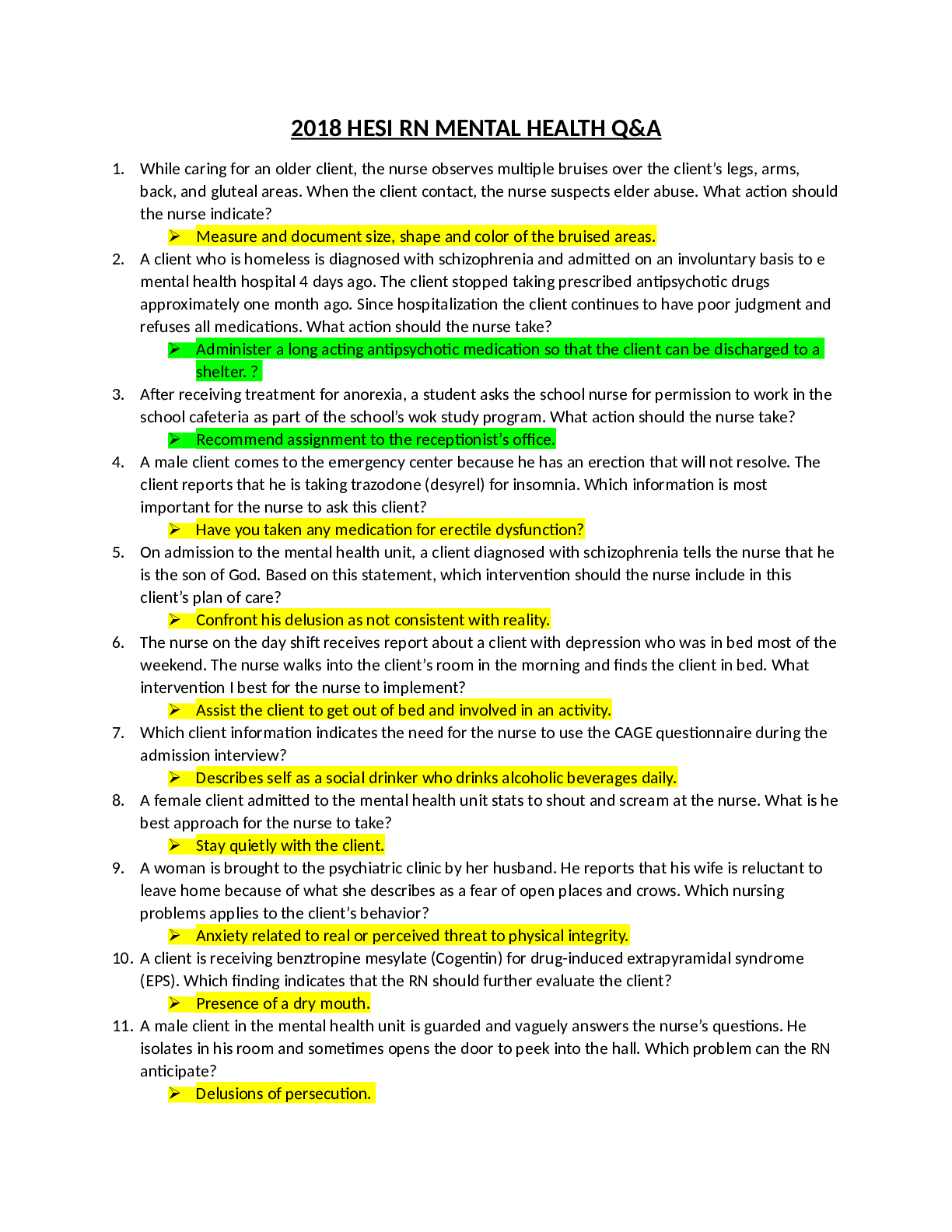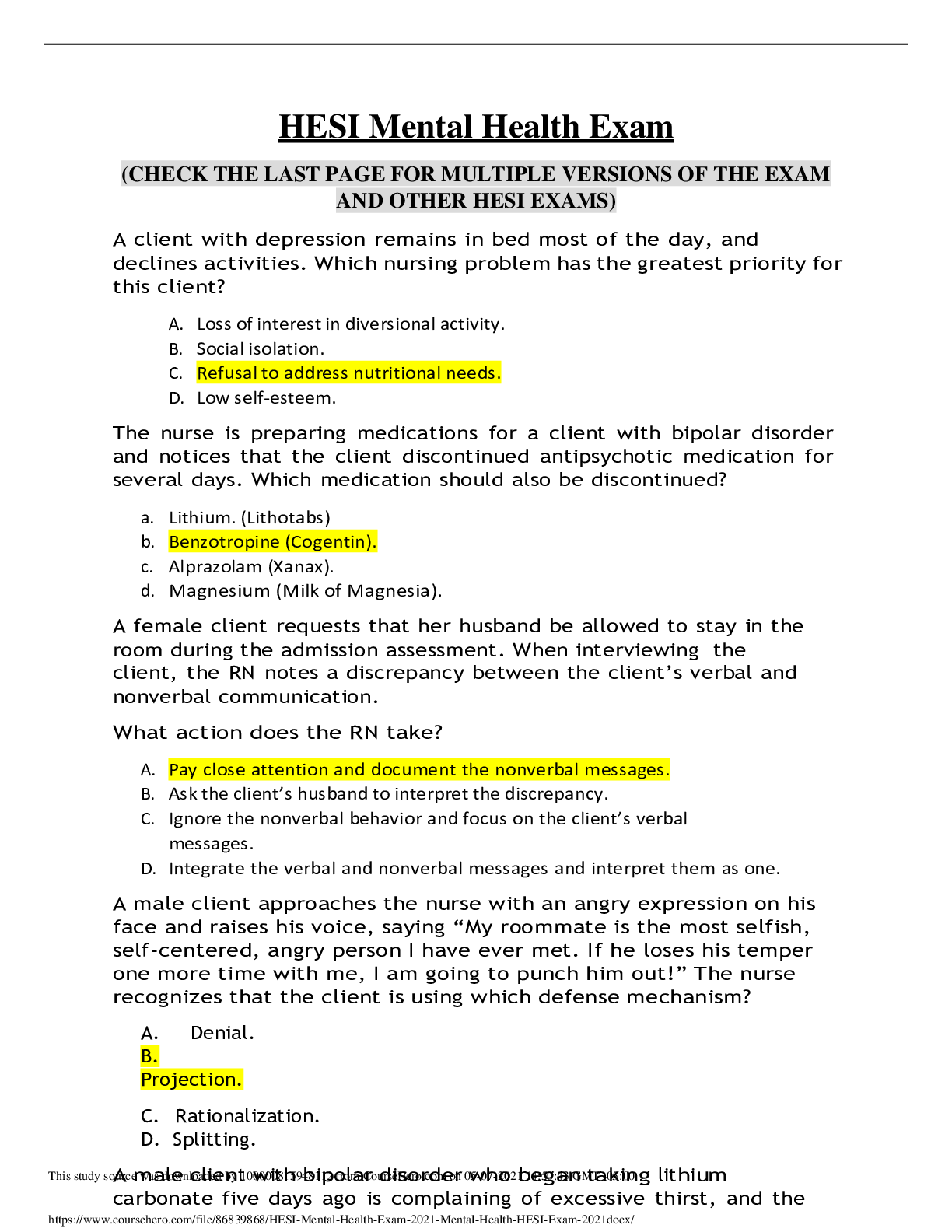*NURSING > HESI > HESI MENTAL HEALTH RN V1-V3 2019 TEST BANKS (ALL TOGETHER). 2020 HESI Mental health V1-V3 150+ pract (All)
HESI MENTAL HEALTH RN V1-V3 2019 TEST BANKS (ALL TOGETHER). 2020 HESI Mental health V1-V3 150+ practice questions with 50+ pages review study guide & Bonus hesi hints printable immediate download
Document Content and Description Below
HESI MENTAL HEALTH RN V1-V3 2019 TEST BANKS (ALL TOGETHER) A client with depression remains in bed most of the day, and declines activities. Which nursing problem has the greatest priority for this c... lient? A. Loss of interest in diversional activity. B. Social isolation. C. Refusal to address nutritional needs. D. Low self-esteem. The RN is preparing medications for a client with bipolar disorder and notices that the client discontinued antipsychotic medication for several days. Which medication should also be discontinued? a. Lithium. (Lithotabs) b. Benzotropine (Cogentin). c. Alprazolam (Xanax). d. Magnesium (Milk of Magnesia). A female client requests that her husband be allowed to stay in the room during the admission assessment. When interviewing the client, the RN notes a discrepancy between the client’s verbal and nonverbal communication. What action does the RN take? A. Pay close attention and document the nonverbal messages. B. Ask the client’s husband to interpret the discrepancy. C. Ignore the nonverbal behavior and focus on the client’s verbal messages. D. Integrate the verbal and nonverbal messages and interpret them as one. A male client approaches the RN with an angry expression on his face and raises his voice, saying “My roommate is the most selfish, self-centered, angry person I have ever met. If he loses his temper one more time with me, I am going to punch him out!” The RN recognizes that the client is using which defense mechanism? A. Denial. B. Projection. C. Rationalization. D. Splitting. A male client with bipolar disorder who began taking lithium carbonate five days ago is complaining of excessive thirst, and the RN finds him attempting to drink water from the bathroom sink faucet. Which intervention should the RN implement? A. Report the client’s serum lithium level to the HCP. B. Encourage the client to suck on hard candy to relieve the symptoms. C. No action is needed since polydipsia is a common side effect. D. Tell the client that drinking from the faucet is not allowed. The RN is teaching a client about the initiation of the prescribed abstinence therapy using disulfiram (Antabuse). What information should the client acknowledge understanding? A. Completely abstain from heroin or cocaine use. B. Remain alcohol free for 12 hours prior to the first dose. C. Attend monthly meetings of alcoholics anonymous. D. Admit to others that he is a substance user. A male client with schizophrenia is admitted to the mental health unit after abruptly stopping his prescription for ziprasidone (Geodon) one month ago. Which question is most important for the RN to ask the client? A. Have you lost interest in the things that you used to enjoy? B. Is your ability to think or concentrate decreased? C. How many continuous hours do you sleep at night? D. Do you hear sounds or voices that others do not hear? During an annual physical by the occupational RN working in a corporate clinic, a male employee tells the RN that is high-stress job is causing trouble in his personal life. He further explains that he often gets so angry while driving to and from work that he has considered “getting even” with other drivers. How should the RN respond? A. “Anger is contagious and could result in major confrontation.” B. “Try not to let your anger cause you to act impulsively.” C. “Expressing your anger to a stranger could result in an unsafe situation.” D. “It sounds as if there are many situations that make you feel angry.” A client who has agoraphobia (a fear of crowds) is beginning desensitization with the therapist, and the RN is reinforcing the process. Which intervention has the highest priority for this client’s plan of care? A. Encourage substitution of positive thoughts and negative ones. B. Establish trust by providing a calm, safe environment. C. Progressively expose the client to larger crowds. D. Encourage deep breathing when anxiety escalates in a crowd. Which nursing actions are likely to help promote the self-esteem of a male client with modern depression? A. Ask the client what his long term goals are. B. Discuss the challenges of his medical condition. C. Include the client in determining treatment protocol. D. Encourage the client to engage in recreational therapy. E. Provide opportunities for the client to discuss his concerns. A male client is admitted to the psychiatric unit for recurrent negative symptoms of chronic schizophrenia and medication adjustment of Risperidone (Risperdal). When the client walks to the nurse’s station in a laterally contracted position, he states that something has made his body contort into a monster. What action should the RN take? A. Medicate the client with the prescribed antipsychotic thioridazine (Mellaril). B. Offer the client a prescribed physical therapy hot pack for muscle spasms. C. Direct client to occupational therapy to distract him from somatic complaints. D. Administer the prescribed anticholinergic benztropine (Cogentin) for dystonia. A mental health worker is caring for a client with escalating aggressive behavior. Which action by the MHW warrant immediate intervention by the RN? A. Is attempting to physically restrain the patient. B. Tells the client to go to the quiet area of the unit. C. Is using a loid voice to talk to the client. D. Remains at a distance of 4 feet from the client. A client on the mental health unit is becoming more agitated, shouting at the staff, and pacing in the hallway. When the PRN medication is offered, the client refuses the medication and defiantly sits on the floor in the middle of the unit hallway. What nursing intervention should the RN implement first? A. Transport of the client to the seclusion room. B. Quietly approach the client with additional staff members. C. Take other clients in the area to the client lounge. D. Administer medication to chemically restrain the patient. A client is admitted to the mental health unit and reports taking extra antianxiety medication because, “I’m so stressed out. I just want to go to sleep.” The RN should plan one-on-one observation of the client based on which statement? A. “What should I do? Nothing seems to help.” B. “I have been so tired lately and needed to sleep.” C. “I really think that I don’t need to be here.” D. “I don’t want to walk. Nothing matters anymore.” A male hospital employee is pushed out the way by a female employee because of an oncoming gurney. The pushed employee becomes very angry and swings at the female employee. Both employees are referred for counseling with the staff psychiatric RN. Which factor in the pushed employee’s history is most related to the reaction that occurred? A. Is worried about losing his job to a woman. B. Tortured animals as a child. C. Was physically abused by his mother. D. Hates to be touched by anyone. The RN documents the mental status of a female client who has been hospitalized for several days by court order. The client states, “I don’t need to be here” and tells the RN that she believes the television talks to her. The RN should document these assessment findings in which section of the mental status exam/ A. Level of concentration. B. Insight and judgement. C. Remote memory. D. Mood and affect. A client is admitted to the mental health unit reports shortness of breath and dizziness. The client tells the RN, “I feel like I’m going to die”. Which nursing problem should the RN include in this client’s plan of care? A. Mood disturbance. B. Moderate anxiety. C. Altered thoughts. D. Social isolation. A female client who is wearing dirty clothes and has foul body odor, comes to the clinic reporting feeling scared because she is being stalked. What action is most important for the RN to take? A. Offer the client a safe place to relax before interviewing her. B. Ask the client to describe why she is being stalked. C. Recommend that the client talk with a social worker. D. Assure the client that the HCP will see her today. The RN leading a group session of adolescent clients gives the members a handout about anger management. One of the male clients is fidgety, interrupts peers when they try and talk, and talks about his pets at home. What nursing action is best for the RN to take? A. Explore the client’s feelings about his pets and home life. B. Encourage his peers to help involve him in the activity. C. Give the client permission to leave and return in 10 minutes. D. Redirect him by encouraging him to read from the handout. A male adolescent was admitted to the unit two days ago for depression. When the mental health RN tries to interview the client to establish rapport, he becomes very irritated and sarcastic. Which action is best for the RN to take? A. Report the behavior to the next shift. B. Offer to play a game of cards with the client. C. Document the behavior in the chart. D. Plan to talk with the client the next day. A male adult is admitted because of an acetaminophen (Tylenol) overdose. After transfer to the mental health unit, the client is told he has liver damage. Which information is most important for the nurse to include in the client's discharge plan? A. Do not take any over the counter meds. B. Eat a high carb, low fat, low protein diet. C. Call the crisis hotline if feeling lonely. D. Avoid exposure to large crowds. After receiving treatment for anorexia, a student asks the school RN for permission to work in the school cafeteria as part of the school’s work study program. What action should the RN take? A. Refer the student to a psychiatrist for further discussion. B. Recommend assignment to the receptionist’s office. C. Suggest that student work in the athletic department. D. Determine the parent’s opinion of the work assignment. The Rn accepts a transfer to the metal health unit and understands that the client is distractible and is exhibiting a decreased ability to concentrate. The RN only has 15 minutes to talk to the client. To develop treatment plan for this client, which assessment is most important for the RN to obtain? A. Motivation of treatment. B. History of substance use. C. Medication compliance. D. Mental status examination. A male client who recently lost a loved one arrives at the mental health center and tells the RN he is no longer interested is his usual activities and has not slept for several days. Which priority nursing problem should the RN include in the client’s plan of care? A. Risk for suicide. B. Sleep deprivation. C. Situational low self-esteem. D. Social isolation. A male client with long history of alcohol dependency arrives in the emergency department describing the feelings of bugs crawling on his body. His blood pressure is 170/102, his pulse rate is 110 bpm, and is blood alcohol level is 0mg/dL. Which prescription should the RN administer? A. Haloperidol (Haldol). B. Thiamine (Vitamin B1). C. Diphenhydramine (Benadryl). D. Lorazepam (Ativan). A client who refuses antipsychotic medications disrupts group activities, talks with nonsensical words and wanders into client’s rooms. The RN decides that the client needs constant observation based on which of these assessment findings? A. Wanders into the clients rooms. B. Refuses antipsychotic medications. C. Talks with nonsensical words. D. Disrupts group activities. A client with schizophrenia explains that she has 20 children and then very seriously points to the RN and explains that she is one of them. What is the most therapeutic response for the RN to provide/ A. “Let’s go ask another RN is this is true.” B. “My name tag shows that I am a RN here.” C. “I can’t possibly be one if your children.” D. “I know that you don’t have 20 children.” A high school girl reveals to the high school RN that she has been engaging in self-induced vomiting as weight-control measure. Which initial assessment should the RN focus on with this adolescent? A. National percentile of weight and height. B. Frequency of bingeing and purging behaviors. C. Perceptions of family and social relationships. D. School grades and extracurricular activities. Narcan was administered to an adult client following a suicide attempt with an overdose of hydrocodone bitartrate (Vicodin). Within 15 minutes, the client is alert and oriented. In planning nursing care, which intervention has the highest priority at this time? A. Encourage the client to increase fluid intake. B. Obtain the client’s serum Vicodin level. C. Observe the client for further narcotic effects. D. Determine the client’s reason for attempting suicide. Following surgery, a male client with antisocial personality disorder frequently requests that a specific RN be assigned to is care and is belligerent when another RN is assigned. What action should the charge RN implement? A. Reassure the client that his request will be met whenever possible. B. Advise the client that assignments are not based on the client’s request. C. Ask the client to explain why he constantly requests the RN. D. Encourage the client to verbalize his feelings about the RN. When preparing to administer a prescribed medication to a homeless male at a community clinic, the client tells the RN that he usually takes a different dosage. What action should the RN take? A. Tell him to take the medication then verify the dosage at the next healthcare team meeting. B. Withhold the medication until the dosage can be confirmed. C. Inform him that he may refuse the medication and document whether or not he takes it. D. Explain to the client that the dosage has been changed. The nurse orients a female client with depression to the new room on the mental health unit. The client states “It seems strange that I don’t have a T.V in my room.” Which statement would be best for the RN to provide? A. “You can watch T.V as much as you want outside of your room.” B. “Sometimes clients feel like the T.V is sending them messages.” C. “It’s important to be out of you room and talking to others.” D. “Watching T.V is a passive activity and we want you to be active.” A client admitted with a closed head injury after a fall has a blood alcohol level of 0.28 (28%) and is difficult to arouse. Which intervention during the first 6 hours following admission should the RN identify as the priority? A. Give lorazepam (Ativan) PRN for signs of withdrawal. B. Administer disulfiram (Antabuse) immediately. C. Place in a side lying position with head of bed elevated. D. Provide thiamine and folate supplements as prescribed. The RN is completing the admission assessment of an underweight adolescent who is admitted to a psychiatric unit with a diagnosis of depression. Which finding requires notification to the HCP? A. Potassium level of 2.9 mEq/dl. B. Blood pressure of 110/70 mmHg. C. WBC of 10,000mm^3. D. Body mass index of 21. The Rn is planning client teaching for a 35-year-old client with alcoholic cirrhosis. Which self-care measure should the RN emphasize for the client’s recovery? A. Support group meetings. B. Vitamin B and multivitamin supplements. C. Diet with adequate calories and protein. D. Alcohol abstinence. A teenager has lost 20 pounds in the last three months is admitted to the hospital with hypotension and tachycardia. The client reports irregular menses and hair loss. Which intervention is most important for the RN to include in the clients plan of care? A. Implement behavioral modification therapy. B. Initiate caloric and nutritional therapy. C. Evaluate the client for low self-esteem. D. Record daily weights and graft trend. While interviewing a client, the nurse takes notes to assist with accurate documentation later. Which statement is most accurate regarding note-taking during an interview? A. The client’s comfort level is increased when the RN breaks eye contact to take notes. B. The interview process is enhanced with note taking and allows the client to speak at a normal pace. C. Taking notes during an interview is a legal obligation of examining RN. D. The RN’s ability to directly observe the client’s non-verbal communication is limited with note taking. A client is receiving substitution therapy during withdrawal from benzodiazepines. Which expected outcome statement has the highest priority when planning nursing care? a. Client will not demonstrate cross addiction. b. Co-dependent behaviors will be decreased. c. CNS stimulation will be reduced. d. Client's level of consciousness will increase. A client who is being treated with lithium carbonate for manic depression begins to develop diarrhea, vomiting, and drowsiness. What action should the nurse take? a. Notify the physician immediately and force fluids. b. Prior to giving the next dose, notify the physician of the symptoms. c. Record the symptoms and continue medication as prescribed. d. Hold the medication and refuse to administer additional amounts of the drug. While caring for an older client, the RN observes multiple bruises in Over the client’s legs, arms, back, and gluteal areas. When the client Contact, the RN suspects elder abuse. What action should the RN take? A. Report family conversations and anger towards the client when visiting. B. Ask the client specific questions about someone causing the bruising. C. Question the family members and caregiver how the bruising occurred. D. Measure and document size, shape and color of the bruised areas. The RN is performing intake interviews at a psychiatric clinic. A female client with a known history of drug abuse reports that she had a heart attack four years ago. Use of which substance places the client at highest risk for myocardial infarction? A. Benzodiazepine B. Alcohol C. Methamphetamine D. Marijuana After receiving treatment for anorexia, a student asks the school RN for permission to work in the school cafeteria as part of the school’s work study program. What action should the RN take? A. Suggest that the student work in the athletic department. B. Determine the parent’s opinion of the work assignments. C. Refer the student to a psychiatrist for further discussion. D. Recommend assignment to the receptionist’s office. A client who is homeless is diagnosed with schizophrenia and admitted on an involuntary basis to a mental health hospital 4 days ago. The client stopped taking prescribed antipsychotic drugs approximately one month ago. Since hospitalization the client continues to have poor judgment and refuses all medications. What action should the RN take? A. Encourage the client to stay in the hospital so the client does not have to be homeless. B. Provide the client with medication if the client presents an imminent risk to self and others. C. Administer a long acting antipsychotic medication so that the client can be discharged to a shelter. D. Describe to the client treatment options provided at the community mental health clinics. A male client comes to the emergency center because he has an erection that will not resolve. The client reports that he is taking trazodone (Desyrel) for insomnia. Which information is most important for the nurse ask the client? A. When was the last time you drank alcoholic beverage? B. Have you taken any medications for erectile dysfunction? C. Are you having any other sexual dysfunctions or problems? D. Do you have a history of angina or high blood pressure? On admission to the mental health unit, a client diagnosed with schizophrenia tells the RN that he is the son of god. Based on this statement, which intervention should the RN include in this client’s plan of care? A. Lead the client by his arm to the seclusion room. B. Ensure the client’s environment is safe. C. Schedule activity therapy twice a week. D. Confront his delusion as not consistent with reality. The RN on the day shift receive report about a client with depression who was in bed most of the weekend. The RN walks into the client’s room in the morning and finds the client in bed. What intervention is best for the RN to implement? A. Monitor the client’s appetite and pattern of sleep. B. Assess the client’s feelings about the hospital stay. C. Assist the client to get out of bed and involved in an activity. D. Explain that staff will check on the client every 30 minutes. Which client information indicates the need for the RN to use CAGE questionnaire during the admission interview? A. Client’s medication history includes the frequent use of antidepressants. B. Describe self as a social drinker who drinks alcoholic beverages daily. C. Reports difficulties with short term memory since traumatic brain injury. D. Medical history includes that the client was recently sexually assaulted. A female client admitted to the mental health unit starts to shout and scream at the RN. What is the best approach for the RN to take? A. Stay quietly with the patient B. Tell her that she is out of control. C. Distract her by offering her finger foods. D. Ignore the client’s acting out behavior. A woman is brought to the psychiatric clinic by her husband. He reports that his wife is reluctant to leave home because of what she describes as a fear of open places and crowds. Which nursing problem applies to this client’s behavior? A. Ineffective protection to guard self from internal or external threats. B. Risk for injury related to inability to communicate. C. Risk prone health behavior related to self-esteem assault. D. Anxiety related to real or perceived threat to physical integrity. A client is receiving benztropine mesylate (Cogentin) for drug-induced extrapyramidal syndrome (EPS). Which finding indicates that the RN should further evaluate the client? A. Decreased bowel movements. B. Presence of a dry mouth. C. Decreasing hand tremors. D. Increased mouth movements. A male client in the mental health unit is guarded and vaguely answers the nurse’s questions. He isolates in his room and sometimes opens the door to peek into the hall. Which problem can the RN anticipate? A. Visual hallucinations. B. Auditory hallucinations. C. Excessive motor activity. D. Delusions of persecution. A female client with obsessive compulsive personality disorder is admitted to the hospital for a cardiac catheterization. The afternoon before the procedure, the client begins to keep detailed notes of the nursing care she is receiving, and reports her findings to the RN at bedtime. What action should the nurse implement? A. Explain to the client that her behavior invades the rights of the nursing staff. B. Ask the client to explain why she is keeping a detailed record of her nursing care. C. Teach the client strategies to control her obsessive compulsive behavior. D. Encourage the client to express her feelings regarding the upcoming procedure. During admission to the psychiatric unit, a female client is extremely anxious and states that she is worried about the sun coming up the next day. What intervention is most important for the RN to implement during the admission process? A. Assist the client in developing alternative coping skills. B. Remain calm and use a matter of fact approach. C. Ask the client why she is so anxious D. Administer a PRN sedative to help relieve her anxiety. A female client is brought to the emergency department after police officers found her disoriented, disorganized, and confused. The RN also determines that the client is homeless and is exhibiting suspiciousness. The client’s plan of care should include what priority problem? A. Acute confusion. B. Ineffective community coping C. Disturbed sensory perception. D. Self-care deficit. The occupational health nurse is working with a female employee who was just notified that her child was involved in a MVA and taken to the hospital. The employee states, “I can’t believe this. What should I do?” Which response is best for the RN to provide in this crisis? A. Tell me what you think should happen. B. How serious was the collision? C. What do you think you should do? D. Call for transportation to the hospital. A client tells the RN that he has an IQ of 400+ and is a genius and an inventor. He also reports that he is married to a female movie star and thinks that his brother wants a sexual relationship with her. What is the priority nursing problem for admission to the psychiatric unit? A. Ineffective sexual patterns. B. Impaired environmental interpretation. C. Disturbed sensory perception. D. Compromised family coping. The RN is providing care for a client diagnosed with borderline personality disorder who has self-inflicted lacerations on the abdomen. Which approach should the RN use when changing this client’s dressing? A. Provide detailed thorough explanations when cleansing wound. B. Perform the dressing change in a non-judgmental manner. C. Ask in a non-threatening manner why the client cut own abdomen. D. Request another staff member assist with the dressing change. While sitting in the day room of the mental health unit, a male adolescent avoids eye contact, looks at the floor, and talks softly when interacting verbally with the RN. The two trade places, and the RN demonstrates the client’s behaviors. What is the main goal of this therapeutic technique? A. Initiate a non-threatening conversation with the client. B. Dialog about the ineffectiveness of his interactions. C. Allow the client to identify the way he interacts. D. Discuss the client’s feelings when he responds. An antidepressant medication is prescribed for a client who reports sleeping only 4 hours in the past 2 days and weight loss of 9 lbs within the last month. Which client goal is most important to achieve within the first three days of treatment? A. Meet scheduled appointment with dietitian. B. Sleep at least 6 hours a night. C. Understands the purpose of the medication regimen. D. Describes the reasons for hospitalization. When preparing to administer to domestic violence screening tool to a female client, which statement should the RN provide? A. If your partner is abusing you, I need to ask these questions. B. State law mandates that I ask if you are a victim of domestic violence. C. The HCP provider needs to know if you are experiencing any domestic abuse. D. All clients are screened for domestic abuse because it is common in our society. A young adult female visits the mental health clinic complaining of diarrhea, headache, and muscle aches. She is afebrile, denies chills, and all laboratory findings are within normal limits. During the physical assessment, the client tells the RN that her sister thinks she is neurotic and calls her a hypochondriac. Which response is best for the RN to provide? A. Unless your sister has a medical education, ignore her comments. B. I can hear that your sister comments are over-whelming you. C. Do you think it’s possible that you might be a hypochondriac? D. Besides your sister’s comments, what in your life is troubling you? The RN is leading a group on the inpatient psychiatric unit. Which approach should the RN use during the working phase of group development? A. Establishing a rapport with group members. B. Clarifying the nurse’s role and clients’ responsibilities. C. Discussing ways to use new coping skills learned. D. Helping clients identify areas of problem in their lives. A male client with schizophrenia is demonstrating echolalia, which is becoming annoying to other clients on the unit. What intervention is best for the RN to implement? A. Isolate the client from the other clients. B. Administer PRN sedative. C. Avoid recognizing the behavior. D. Escort the client to his room. A client is admitted for bipolar disorder and alcohol withdrawal, depressive phase. Based on which assessment finding will the RN withhold the clonidine (Catapres) prescription? A. Blood pressure readings of 90/62 mmHg to 92/58 mmHg. B. Pulse rate of 68-78 BPM. C. Temperature of 99.5-99.7 F. D. Respiration rate of 24 breaths per minute. The RN on the evening shift receives report that a client is scheduled for electroconvulsive treatment (ECT) in the morning. Which intervention should the Rn implement the evening before the scheduled ECT? A. Hold all bedtime medications. B. Keep the client NPO after mid-night. C. Implement elopement precautions. D. Give the client an enema at bedtime. A client with Bulimia and depression who is taking phenelzine (Nardil) 90 mg daily is admitted to an acute care hospital for uncontrolled hypertension. What dietary choices should the RN instruct the client to avoid? A. Pan-seared catfish. B. Peperoni pizza. C. Deep fried shrimp. D. Beef trips with gravy. A mental health worker is caring for a client with escalating aggressive behavior. Which action by the mental health worker warrants immediate intervention by the RN? A. Is attempting the physically restrain the patient. B. Remains at a distance of 4 feet from the client. C. Tells the client to go to the quiet area of the unit. D. Is using a load voice to talk to the client. A client who recently experienced the death of a significant other arrives at the mental health center. The client reports loss of interest in usual activities, expresses a wish to be with the decreased significant other, has been eating very little, and has not slept in several days. Which client statement is most important for the RN to explore at this time? A. Not sleeping for several days. B. Wishing to be with spouse. C. Lack of interest in usual activities. D. Eating very little. A middle aged adult with major depressive disorder suffers from psychomotor retardation, hypersomnia, and motivation. Which intervention is likely to be most effective in returning this client to a normal level of functioning? A. Provide education on methods to enhance sleep. B. Teach the client to develop a plan for daily structured activities. C. Suggest that the client develop a list of pleasurable activities. D. Encourage the client to exercise. When developing a plan of care for a client admitted to the psychiatric unit following aspiration of a caustic material related to a suicide attempt, which nursing problem has the highest priority? A. Impaired comfort. B. Risk for injury. C. Ineffective breathing pattern. D. Ineffective coping. A female client on a psychiatric unit is sweating profusely while she vigorously does push-ups and then runs the length of the corridor several times before crashing into furniture in the sitting room. Picking herself up, she begins to toss chairs aside, looking for a red one to sit in. When another client objects to the disturbance, the client shouts, “I am the boss here. I do what I want.” Which nursing problem best supports these observations? A. Deficient diversional activity related to excess energy level. B. Risk for other related violence related to disruptive behavior. C. Risk for activity intolerance related to hyperactivity. D. Disturbed personal identity related to grandiosity. A RN is preparing the physical environment to interview a new client for admission to the mental health unit. Which environmental setting facilitates the best outcome of the interview? A. Dim the lights in the room to help the patient feel calm. B. Sit within two feet of the client to enhance level of safety and security. C. Reduce the noise level in the room by turning off the television and radio. D. Position table between the client and the RN for extra personal space. An older homeless client visits the psychiatric clinic to obtain a prescription renewal for alprazolam (Xanax). During the health assessment, the client complains of chest pain. Which action should the RN take first? A. Refer the client to the cardiology unit. B. Obtain the client Blood pressure. C. Assess the client for substance abuse. D. Determine if Xanax was taken recently. The mother of an 8-month-old infant with profound mental and physical disabilities tells he RN how depressed she is because she realized that her child will never achieve normal growth and development milestones. How should the RN respond to the mother? A. Ask the mother if she has ever thought about harming herself or her child. B. Reassure the mother that her child will achieve some growth and development milestones. C. Determine if the mother has other children who do not have developmental disabilities. D. Encourage the mother to write thoughts and feelings in journal. Several clients with chronic mental illness and multiple substance abuse histories live in a group residential home and attend daycare mental health facility where group and individual therapies are provided. The RN finds the common bathroom at the facility with sputum on the walls, urine in the sink and on the floors, and the toilet stopped up with tissue, paper towels, and feces. What is the priority issue that the RN should address? A. Medication non-compliance. B. Number of bathroom facilities. C. Infection control. D. Acting out behaviors. A client with schizophrenia is admitted to the psychiatric care unit for aggressive behavior, auditory hallucinations, and potential for safe harm. The client has not been taking medications as prescribed and insists that the food has been poisoned and refuses to eat. What intervention should the RN implement? A. Assure the client that all food served in the hospital is safe to eat. B. Tell the client that irrational thinking is a symptom of schizophrenia. C. Obtain an order for a tube feeding for the client. D. Provide the client with food in unopened containers. The RN is providing education about strategies for a safety plan for a female client who is a victim of intimate partner violence. Which strategies should be included in the safety plan? (SOA) A. Purchase a gun to use for protection. B. Establish a code with family and friends to signify violence. C. Take a self-defense course that retaliates the abuser with injury. D. Have a bag ready that has extra clothes for self and children. E. Plan an escape route to use if the abuser blocks the main exit. The RN is admitting a male client who take lithium carbonate (Eskalith) twice a day. Which information should the RN report to the HCP immediately? A. Short term memory loss. B. Five pound weight gain C. Decreased affect. D. Nausea and vomiting. A male client who is admitted with delirium tremens is dehydrated and experiencing auditory hallucinations. He has a bruised, swollen tongue and is confused. In developing a plan of care, which action should the RN include to ensure the client is physiologically stable? A. Encourage oral fluids. B. Monitor vital signs. C. Keep the room dark. D. Apply ice to his tongue. A RN is teaching a client about initiation of a prescribed abstinence therapy using Disulfiram (Antabuse). What information should the client acknowledge understanding? A. Admit to others that he is a substance abuser. B. Remain alcohol free for 12 hours prior to first dose. C. Attend monthly meetings of alcoholics anonymous. D. Completely sustain from heroin or cocaine use. The RN is working with a male client at a community mental health center when the client reports hearing voices that tell him to get a knife from the kitchen and hurt himself. What intervention is most important for the RN to implement? A. Don’t allow the client to go into the kitchen until the hallucination has subsided. B. Report the behavior to the client’s case workers so that the family can be notified. C. Assign the UAP to remain with the client at all times. D. Document the behavior in the client’s record and notify the HCP. A homeless client who reports feeling sad and depressed tells the mental health nurse that in the past 2 days she has only had 4 hours of sleep. Which action is most important for the RN to implement within the first 24 hours after treatment is initiated? A. Allow the client to rest and sleep. B. Ensure client attend groups addressing coping skills for dealing with depression. C. Begin planning for the clients discharge. D. Encourage verbalization of feelings. Which client statement suggests the RN that the client is using a defense mechanism of projection to deal with anxiety related to admission to a psychiatric unit? A. At least I hit the wall instead of hitting the psychiatric aide. B. I am here because the police thought I was doing something wrong. C. I want to be here because I know it is the best psychiatric facility. D. Don’t believe everything my family tells you, I am not crazy. A male client is admitted to the psychiatric inpatient unit with a bandaged flesh wound after attempting to shoot himself. He was divorced one year ago. Lost his job four months ago, and suffered a breakup of is current relationship last week. What is most likely source of this client’s current feelings of depression? A. Feelings of frustration. B. A sense of loss C. Poor self-esteem. D. A lack of intimate relationships. The RN documents the mental status of a female client who has been hospitalized for several days by court order. The client states”I don’t need to be here,” and tells the RN that she believes that the t.v talks to her. The RN should document these assessment statements in which section of the mental status exam? A. Insight and judgement. B. Mood and affect. C. Remote memory. D. Level of concentration. An older ale client with schizophrenia is found smearing feces n the bathroom walls of the chronic mental health unit where he resides. What action should the RN implement? A. Explain that the feces belong in the toilet. B. Show the client how to clean the walls. C. Escort the client out of the bathroom. D. Assist the client to clean the walls. A male client tells the RN that he does not want to take the atypical antipsychotic drug, olanzapine (Zypexa), because of the side effects he experienced when he took the drug for a year. Which experience is most likely related to taking olanzapine? A. Weight gain of 75 lbs. B. Thoughts of wanting to hurt himself. C. Frequent days with diarrhea. D. Alerted liver function test. A college student who is a victim of a car-jacking presents to the community health center and report increased anxiety. During the interview, what nursing intervention should take the highest priority? A. Identify support systems in the community that may be helpful. B. Help the client feel safe to decrease anxiety. C. Ask the client to describe coping strategies that were helpful in the past. D. Encourage the client to verbalize anxiety related to event. The RN completes an assessment of a client who is experiencing intimate partner violence (IPV). Which finding of the injuries should the RN include in the documentation? A. A summary of the client’s feelings. B. Photographs. C. A general description. D. A client’s significant other’s statement. Following involvement in a MVC, a middle aged adult client is admitted to the hospital with multiple facial fractures. The client’s blood alcohol level is high on admission. Which PRN prescription should be administered if the client begins to exhibit signs and symptoms of delirium tremens (DTs)? A. Prochlorperazine (Compazine) 5 mg IM. B. Hydromorphone (Dialuadid) 2 mg IM. C. Chlorpromazine (Thorazine) 50 mg IM. D. Lorazepam (Ativan) 2 mg IM. Patient says “I'm going to shoot myself” a. Stop the client from leaving the unit A client who is known to abuse drugs is admitted to the psychiatric unit. Which medication should the nurse anticipate administering to a client who is exhibiting benzodiazepine withdrawal symptoms? a. Perphenazine (Trilafon). b. Diphenylhydramine (Benadryl). c. Chlordiazepoxide (Librium). d. Isocarboxazid (Marplan). A woman brings her 48-year-old husband to the outpatient psychiatric unit and describes his behavior to the admitting nurse. She states that he has been sleepwalking, cannot remember who he is, and exhibits multiple personalities. The nurse knows that these behaviors are often associated with which condition? a. Dissociative disorder. b. Obsessive-compulsive disorder. c. Panic disorder. d. Post-traumatic stress syndrome. Which diet selection by a depressed client taking tranylcypromine sulfate (Parnate), an MAO inhibitor, indicates to the nurse that the client understands the dietary restrictions imposed by this medication regimen? a. Hamburger, french fries, and chocolate milkshake. b. Liver and onions, broccoli, and decaffeinated coffee. c. Pepperoni and cheese pizza, tossed salad, and soda. d. Roast beef, baked potato with butter, and iced tea. A female client on a psychiatric unit is sweating profusely while she vigorously does pushups and then runs the length of the corridor several times before crashing in to the furniture in the sitting room. Picking herself up, she begins to toss chairs aside, looking for a red one to sit in. When another client objects to the disturbances, the client shouts," I am the boss here. I do what I want." Which nursing problem best supports these observations -Risk for other related violence related to disruptive behavior 8. A female client engages in repeated checks of door and window locks. Behavior that prevents her form arriving on time and interferes with her ability to function effectively. What action should the nures take? -plan a list of activities to be carried out daily 9. The nurse is preparing medications for a client with disorder and notices that the antipsychotic medication was discontinued several days ago. Which medication should also be discontinued? -Benztropine (Cogentin) 10. The nurse is teaching a client about the initiation of a prescribed abstinence therapy using disulfiram (Antabuse). What information should the client acknowledge understanding -remain alcohol free for 12 hours prior to the first dose 11. A male client with bipolar disorder tells the nurse that he needs to "make some deals so that he can improve his retirement savings." Based on this information, which client outcome should the nurse include in the plan of care -delay business decisions until his mania subsides 12. teenaged girl self induced vomiting -frequency of binging and purging behaviors 13. Pt is getting oreiented to the unit and replies “there are no TVs in the room” What is the nurse’s best respond? -it is important to be out of your room and talking to others 14. A male adult is admitted because of an acetaminophen (Tylenol) overdose. After transfer to the mental health unit, the client is told he has liver damage. Which information is most important for the nurse to include in the client's discharge plan? -do not take any over the counter meds 15. The nurse documents the mental status of a female client who has been hospitalized for several days by court order, The client states, "I don't need to be here" and tells the nurse that she believes that the television talks to her. The nurse should document these assessment findings in which section of the mental status exam? -insight and judgement 16. A client who has agoraphobia (a fear of crowds) is beginning desensitization with the therapist, and the nurse is reinforcing the process. Which intervention has the highest priority for this client's plan of care? -establish trust by providing a calm, safe environment 17. ECT therapy is not working, pt is non responsive to treatment what question should the nurse ask? -have you taken erectile dysfunction meds 18. adolescent teen interrupts group about pets at home -redirect him to read from materials 19. depressed pt in bed all weekend, nuse finds pt still in bed on her shift, what is the best action to take? -get client out of bed and active 20.postpartum depression Sign & Symptoms (3) -distrubed sleep, sadness, poor concentration 21.ECT pre treatment teaching -NPO after midnight 24. client who refuses antipsychotic medication disrupt group activities nurse decides client needs constant observation based on? -wanders into client's room 25. recurrent negative symptoms of chronic schizophrenia and medication risperdal. walks laterally contracted position, something has made his body contort -administer the prescribed anticholinergic benztropine (cogentin) for dystonia 26. depression remains in bed most of the day, declines activities and refuses meals -refusal to address nutritional needs 27. Victim of intimate partner violence what 3 things should you do? SELECT ALL THAT APPLY (only 3 correct answers) 1.establish a code with family and friends to signify violence, 2.plan an escape route to use if the abuser blocks main exit, 3.have a bag ready that has extra clothes for self and children 28. patient taking sertraline (zoloft) for postpartum depression, nursing teaching -contact healthcare provider if having suicidal thoughts (black box warning) 29. client sitting in corner of day room during admission assessment, what nursing action -ask client simple questions 30. Psychomotor retardation, hypersomnia, and amotivation; what nursing intervention? -teach client to have daily structured activities 31. Client makes a statement I feel like im going to die, what level of Anxiety is it? -moderate anxiety 32.TOOL assessment - cut down on your drinking, people annoyed you, felt bad or guilty about your drinking, drink first thing in the morning hangover (Eye-opener) 33. What documentation to include for abuse pts -photographs 34. Male nurse swings on female nurse for pushing him out of the way of a gurney. What is the kind of abuse? -abused by mother as a child 35. Anorexic pt asking to work as a cook what is the nurse best response? -encourage to work as a secretary 36. Client overdose on acetaminophen (Tylenol). What should the nurse monitor next? -check for more narcotic effects 37. Client is increasing getting aggressive - remove other pts to another area 38. Angry pt because of coworkers, then a car accident, what is the nurse best response? -“several things made you angry?” 39. The nurse is teaching a pt about disulfiram (Antabuse) -Refrain from alcohol 12 hrs prior to first dose On admission to a residential care facility, an elderly female client tells the nurse that she enjoys cooking, quilting, and watching television. Twenty-fours after admission, the nurse notes that the client is withdrawn and isolated. It is best for the nurse to encourage this client to become involved in which activity? A) Clean the unit kitchen cabinets. B) Participate in a group quilting project. C) Watch television in the activity room. D) Bake a cake for a resident's birthday. A male adolescent is admitted with bipolar disorder after being released from jail for assault with a deadly weapon. When the nurse asks the teen to identify his reason for the assault, he replies, "Because he made me mad!" Which goal is best for the nurse to include in the client's plan of care? The client will A) outline methods for managing anger. B) control impulsive actions toward self and others. C) verbalize feelings when anger occurs. D) recognize consequences for behaviors exhibited. A 35-year-old male client who has been hospitalized for two weeks for chronic paranoia continues to state that someone is trying to steal his clothing. Which action should the nurse implement? A) Encourage the client to actively participate in assigned activities on the unit. B) Place a lock on the client's closet. C) Ignore the client's paranoid ideation to extinguish these behaviors. D) Explain to the client that his suspicions are false. A nurse working on a mental health unit receives a community call from a person who is tearful and states, "I just feel so nervous all of the time. I don't know what to do about my problems. I haven't been able to sleep at night and have hardly eaten for the past 3 or 4 days." The nurse should initiate a referral based on which assessment? A) Altered thought processes. B) Moderate levels of anxiety. C) Inadequate social support. D) Altered health maintenance. A child is brought to the emergency room with a broken arm. Because of other injuries, the nurse suspects the child may be a victim of abuse. When the nurse tries to give the child an injection, the child's mother becomes very loud and shouts, "I won't leave my son! Don't you touch him! You'll hurt my child!" What is the best interpretation of the mother's statements? The mother is A) regressing to an earlier behavior pattern. B) sublimating her anger. C) projecting her feelings onto the nurse. D) suppressing her fear. An anxious client expressing a fear of people and open places is admitted to the psychiatric unit. What is the most effective way for the nurse to assist this client? A) Plan an outing within the first week of admission. B) Distract her whenever she expresses her discomfort about being with others. C) Confront her fears and discuss the possible causes of these fears. D) Accompany her outside for an increasing amount of time each day. The nurse suspects child abuse when assessing a 3-year-old boy and noticing several small, round burns on his legs and trunk that might be the result of cigarette burns. Which parental behavior provides the greatest validation for such suspicions? A) The parents' explanation of how the burns occurred is different from the child's explanation of how they occurred. B) The parents seem to dismiss the severity of the child's burns, saying they are very small and have not posed any problem. C) The parents become very anxious when the nurse suggests that the child may need to be admitted for further evaluation. D) The parents tell the nurse that the child was burned in a house fire which is incompatible with the nurse's observation of the type of burn. The nurse is planning care for a 32-year-old male client diagnosed with HIV infection who has a history of chronic depression. Recently, the client's viral load has begun to increase rather than decrease despite his adherence to the HIV drug regimen. What should the nurse do first while taking the client's history upon admission to the hospital? A) Determine if the client attends a support group weekly. B) Hold all antidepressant medications until further notice. C) Ask the client if he takes St. John's Wort routinely. D) Have the client describe any recent changes in mood. A 35-year-old male client on the psychiatric ward of a general hospital believes that someone is trying to poison him. The nurse understands that a client's delusions are most likely related to his A) early childhood experiences involving authority issues. B) anger about being hospitalized. C) low self-esteem. D) phobic fear of food. The nurse plans to help an 18-year-old female mentally retarded client ambulate the first postoperative day after an appendectomy. When the nurse tells the client it is time to get out of bed, the client becomes angry and tells the nurse, "Get out of here! I'll get up when I'm ready!" Which response is best for the nurse to make? A) Your healthcare provider has prescribed ambulation on the first postoperative day. B) You must ambulate to avoid complications which could cause more discomfort than ambulating. C) I know how you feel. You're angry about having to ambulate, but this will help you get well. D) I'll be back in 30 minutes to help you get out of bed and walk around the room. A client is admitted with a diagnosis of depression. The nurse knows that which characteristic is most indicative of depression? A) Grandiose ideation. B) Self-destructive thoughts. C) Suspiciousness of others. D) A negative view of self and the future. A 65-year-old female client complains to the nurse that recently she has been hearing voices. What question should the nurse ask this client first? A) Do you have problems with hallucinations? B) Are you ever alone when you hear the voices? C) Has anyone in your family had hearing problems? D) Do you see things that others cannot see? woman who is bipolar is wearing low cut blouse, and skirt with no underwear, what does nurse do? Walk her to room and help her pick out something more appropriate Older man who recently got divorced and is 2 years sober, and an alcoholic loves God. He loves kids also. What should nurse ask at his initial interaction? What is your biggest concern? Woman is diagnosed with breast cancer and she becomes dependent and asks family members if they can do ADL's that she is fully capable of doing. What is the reason for this behavior? Its expected; regression is a natural start for recovery Patient having to get treated for benzodiazepam and methadone overdose. What do you use? Narcan Patient watching TV starts talking loud to himself. The nurse comes in and can't distract him so turns down the TV. What should the nurse do then? Move client to quieter room In group therapy the charge nurse notices a client increasing to severe levels of anxiety. What should the nurse do? Talk in a calm, approaching manner A chronic depressed older man refuses to leave his room. His family moved away to a further location so they're not able to visit him as much. What approach should the nurse take with this man? May I lay with you for a little? Patient who is really depressed and won't talk or communicate, later is energetic and talkative. What should the nurse do? Closely monitor the patient (could be suicidal) Patient who had generalized anxiety disorder on Xanax long-term. What is the outcome? Importance of not quickly stopping the drug Mother has a 9 month old baby with mental issues and growth issues. The mother comes in and says she's depressed because she’ll never have a normal baby. What should the nurse say? Have you had any thoughts of harming your baby or yourself? Lithium level 1.5. What do you tell the client who had a recent suicide attempt after seeing him become very anxious after hearing his Lithium levels? drink 2-3L of water in 24 hours Woman comes into ED having been raped by her date. What should the nurse document? document she stated "I was raped by my date" Which patient would require CAGE assessment? Alcohol patient, cut down, annoyed, guilty, eye opener A nurse is changing a dressing on a bipolar patient's stomach from self-inflicting knife wound. What is the nurse's best approach? showing no signs of being judgmental Woman is at a meeting with you, what is important for the nurse to document after hearing her issues in the relationship get spouses statement as well patient in corner with paranoid symptoms, staring and watching you. They refused to communicate with you. What do you do? ask simple questions patient states "I can't get my thoughts together I should really sell my car. It’s not in here. Let's buy a car. What is the patient experiencing? Tangential thinking A depressed adolescent becomes sarcastic and irritates when you start to ask him questions. What does the nurse do? Ask him to play cards A patient who has been on an antidepressant for 2 weeks. What should you watch for? suicidal attempts A patient won't take oral meds that is going through alcohol withdrawal. The nurse starts giving saline lock per alcohol protocol and thiamine. What do you tell them that it will help with recovery? Thiamine will replenish alcohol effects on the body (something to do with iron) A male patient got divorced a year ago, lost his job, and recently suffered from a break up. What is his reason for his recent depression? feelings of loss A patient is being admitted for drug overdose. She says the reason she is using drugs is because of a recent breakup of an intimate relationship? what does the nurse do first ask the patient if they feel as if they have a plan of suicide a bipolar patient has stopped taking an antipsychotic. What other medication should the nurse expect to be D/C benzotropine (Congentin) what should you recommend to a patient saying she can't get any sleep recently after receiving news she has breast cancer. What medication should you recommend? Ativan A patient has possessions she doesn't trust anyone to hold because she thinks they will steal them. How does the nurse establish trust? make sure to talk short comments every now and then to her 1. Part Three 2. A male adult comes to the mental health clinic and walks back and forth in front of the office door, but does not enter the office. He then walks around a chair that is in the hallway several times before sitting down in the chair. What action should the nurse take first observe the client in the chair? 3. A female client engages in repeated checks of door and window locks. Behavior that prevents her from arriving on time and interferes with her ability to function e²ectively. What action should the nurse take plan a list of activities to be carried out daily. 4. A male client with schizophrenia is admitted to the mental health unit after abruptly stopping his prescription for ziprasidone (Geodon) one month ago. Which question is most important for the nurse to ask the client Do you hear voices. 5. A female client with a history of drinking who was admitted 8 hours ago after receiving treatment for minor abrasions occurred from a fall at home. 6. The nurse determines the client's blood alcohol level (BAL) was not analyzed on administration action should the nurse take Ask client about alcohol quantity, frequency, and time of last drink 7. A female client on a psychiatric unit is sweating profusely while she vigorously does push-ups and then runs the length of the corridor several times before crashing into the furniture in the sitting room. Picking herself up, she begins to toss chairs aside, looking for a red one to sit in. When another client objects to the disturbances, the client shouts," I am the boss here. I do what I want." Which nursing problem best supports these observations Risk for other related violence related to disruptive 8. What is the most important goal for a client diagnosed with major depression who has been receiving an antidepressant medication for two weeks not attempt to commit suicide 9. Alcohol-Pancreatitis health assessment of history of alcohol dependency WHAT ELSE WOULD BE A CONCERN pancreatitis 10. Anorexia Nervosa-syncope Syncope is a clinical feature Abuse-BAL- 11. Admission A female client with a history of drinking who was admitted 8 hours ago after receiving treatment for minor abrasions occurred from a fall at home. The nurse determines the client's blood alcohol level (BAL) was not analyzed on administration action should the nurse take Blood alcohol level- ask the client about alcohol quantity, frequency, and time of the last drink. 12. IPV- difficulty leaving victim of intimate partner violence what 3 things should you do 1. establish a code with family and friends to signify violence, 2. plan an escape route to use if the abuser blocks main exit, 3.have a bag ready that has extra clothes for self and children 13. Anger Management Give the client permission to be angry 14. Antisocial- interrupting A female client with bipolar disorder, manic phase, is planning weekend activities with the other clients on the unit. The client interrupts the group, insists that they change their plans to a disco party, and begins to curse loudly when the group refuses to change the plans. Which intervention should the nurse implement? C. Escort the client to a quieter place. 15. borderline personality disorder self-inflicted lacerations on abdomen perform the dressing change in a non-judgemental manner *ask to summarize-others need time also Borderline-interaction The nurse is assessing a client who is believed to have a borderline personality disorder. Which question is most important to include in this assessment? C. Do you frequently have temper tantrums? Self-critical demanding, whiney, manipulative, argumentative and can be verbally abusive suicidal gestures. borderline personality disorder self-inflicted lacerations on abdomen perform the dressing change in a non -judge mental manner. 16. Conversion disorder patient complains of blindness Conversion disorder Disorder characterized by transferring a mental conflict into a physical symptom for which there is no organic cause. Ex: blindness, paralysis, seizures, deafness, and pseudocyesis(false pregnancy). 17. Countertransference occurs when a mental health care professional redirects his or her feelings toward a client or becomes emotionally entangled with a client counter transference. 18. Part five 19. After returning to work after a weekend off the nurse gets report that a depressed client has been in bed all weekend. What should the nurse to first? 20. Assist the client out of bed and involve in activity. 21. A client with dementia uses the defense mechanism of confabulation. What is the reasoning? 22. To decrease anxiety. 23. A husband states to the nurse that his wife is not sleeping, buying impulsively, taking last minute trips, and has lost 22 pounds one month. What is an appropriate nursing dx? HESI MENTAL HEALTH V3 2017 55 QUESTIONS 24. Disturbed thought process. 25. A nurse is explaining a fire drill routine to a group of clients. A client becomes disruptive and continually interrupts the group. What is the nurse's best response? 26. When you interrupt, I cannot explain what to do to the group. 27. When performing a MSE on a client which assessment intervention would best assist the nurse? 28. Ask the client to interpret the proverb a stitch in time saves nine. 29. A client comes in after being in a car accident and is experiencing alcohol withdrawal, magnesium level of 1.1, cardiac dysthrythmias. What would you give first? 30. Magnesium. 31. A woman is just told of her husband's dx of terminal cancer. What would the nurse offer for the spouse (wife)? 32. How would you like to be involved with your husband's care? 33. A nurse is to remove staples from an abdominal incision, the client is very anxious. What is the most important intervention? 34. Attempt to distract the client with general conversation. 35. A man who was stranded on the roof of his house for two days after a natural disaster, months later ... 36. Implement anxiety control strategies 37. A man dx with bipolar disorder states, "I don't understand, I believe in God and have not done anything to deserve this". What is the nurse's best response? 38. You didn't do anything wrong. You have a chemical imbalance in your brain. 39. A client becomes upset when the nurse he requests is not assigned to him, what is the nurse's best response? 40. Advise the client that nursing assignments are not based on client requests. 41. A client needs to wash her hands for two hours before able to go on with her morning. She doesn't want to sit on the chairs in the dayroom for fear of getting dirty. What is this mechanism? 42. Compulsion. 43. A client in group is talking about her prostitution, the nurse asks her if she was abused by her parents. She states "my mother ran my father out when I was young". What defense mechanism was used? 44. Repression. 45. A woman calls the crisis hotline and says she has a loaded gun and is going to kill herself. To maintain patient confidentiality what would the nurse do? 46. Contact the person the client chooses to go to the home and remove the weapon. 47. A client with anger management issues uses belt making and bangs the leather heavily. What defense mechanisms is being used? 48. Sublimation. 49. A bipolar client comes into the clinic and tells the nurse that the next time she sees her sister I'm going to kill her. What should the nurse do? 50. Inform the sister. 51. What would be the nurse's highest priority for a newly admitted depressed client upon admission? 52. The nurse should go through the client's belongings. 53. Who is most prone to being abused (elder abuse)? 54. Females over 75 living with their families. 55. A client in the dayroom had tipped over a table and is escalating and has picked up a chair which he is threatening to throw at another client. What should the nurse do first? 56. Go and get more staff assistance. 57. A woman who is psychotic is carrying all of her belongings around with her because she is afraid that someone will steal it. What is the best way to establish trust? 58. Make brief contact with the client throughout the day. 59. In adolescent group discussing a handout on anger management, a client is becoming increasingly interruptive and talking about his home and pets. What is the nurse's most appropriate response? 60. Redirect the client to read the handout. 61. What is the most important intervention for a client with bulimia? 62. Plan scheduled meals. 63. A client comes into the ED with DTs. What should the nurse do first? 64. Administer Ativan. 65. What are the side effects of Resperdal? 66. Fever, tachycardia, and sweating. 67. A client who is refusing to take his medication is wandering on the unit and going in and out of resident's rooms. What is the priority? 68. Wandering in and out of other client's rooms. 69. A nurse observes a client in the dayroom talking to himself. What should the nurse do first? 70. Ask the client if he’s currently hearing voices? 71. A client comes to the nurses' station and told the nurse that her roommate had cut her wrists in the bathroom. After assessing and dressing the wounds, what should the nurse do next? 72. Move the client to a private room by the nurse's station. 73. A man comes into the ER after being in a car accident with an alcohol level greater than 2, what should the nurse prepare to administer? 74. Give Ativan (I DONT THINK THIS ONE IS CORRECT) 75. What would be proper teaching for a client who is to start taking Antabuse? 76. Has not had anything alcoholic to drink for the last 48 hours. 77. Alzheimer's patient-nurse goes to do dressing change and the client refuses. What should the nurse do? 78. Leave and come back 30 minutes later. 79. A client is confused in an acute care hospital setting. What would support the dx of delirium instead of dementia? 80. Delirium: Started in hospital. 81. An elderly woman is brought to the ER with multiple stages of healing bruises. What should the nurse do? 82. Take the woman aside and ask her about abuse. 83. A business man is stressed about his finances, has anxiety and sleeplessness. 84. Limit intake of sugar and caffeine. 85. A mother comes into the clinic with her son who is being accused of a crime. She is worried her son will go to jail. What should the nurse say to the mother? 86. Consequences of enabling behaviors. 87. What is a common side effect of cocaine use. 88. Heart attack. 89. A client on LSD comes into the ER. How do you approach the client? 90. Talk calmly and soothing to the client. 91. A client taking Meth and Benzo's, what would the nurse prepare to do for overdose? 92. Give Narcan. 93. An alcoholic father tells his wife and children to stay away from him. What is the most important nursing dx? 94. Risk for injury. 95. onWhat should you advise a patient a MAOI not to eat? 96. Cheese, beer, and avocado. 97. The parents of a teenager who has overdosed what is the first question to ask? 98. What drug did the client ingest? 99. A client becomes agitated when the nurse is talking to his wife. He has not eaten in 3 days. What should the nurse do? 100. Take to quiet room and give PB crackers. 101. When opening a mental health clinic... 102. American Nursing Association. 103. A client with a hx of depression and abusing alcohol with their depression getting worse. What is the most important nursing dx? 104. Ineffective coping. 105. A woman is being abused by her husband, the abuse is escalating. What would the nurse ask first? 106. Do you have a plan in place when you are not safe? (SAFETY!!!) 107. A patient has stopped taking Depakote six months ago, what would the nurse assess? 108. Mood. 109. A nurse visits a community half way house with one bathroom. The nurse notices urine all over the walls of the bathroom. The toilet is clogged with feces and paper towels. 110. Infection control. 111. A client with Alzheimer's keeps asking for his mother. What is the nurses appropriate response? 112. Your mothers not here but you are safe. 113. A client is told to come in by friends, clients complaints include losing his job, just got a divorce, single dad with two kids, what would be the best question for nurse to ask? 114. What is troubling you the most? 115. What are the side effects of Lithium? 116. Dehydration, diarrhea, and thirstiness. 117. A client with an anxiety disorder is demonstrating signs of panic. Which intervention would be the most appropriate for the nurse to implement 118. Decrease environmental stimuli and interactions with other people. 119. A client tells the nurse that he is an accomplished writer and that directors of television shows contact him for suggestions on actors and locations. The nurse realizes this client is experiencing the delusion of 120. Grandiosity 121. A client tells the nurse that his father died after the client thought abut it for a few days. The nurse suspects the client is delusional and is demonstrating: 122. A magical thinking 123. The nurse overhears a client diagnosed with terminal cancer tell a family member that he will be discharged soon, will return to work, and plans to attend a company event scheduled in a year. The nurse realizes this client is demonstrating the defense mechanism of 124. Denial 125. A female client diagnosed with depression tells the nurse that her husband wants her to “fix herself up” and put on nice clothes. The client continues by saying that she believes her husband is interested in another woman. What should the nurse respond to the client? 126. I can help you shower and get dressed before he comes to visit 127. A client diagnosed with schizophrenia has been refusing prescribed oral medication for several days. The client has broken chair and is coming after another client with the broken chair leg, threatening to do physical harm. What should the nurse do first? 128. Remove the other client from the room. 129. The nurse has identified the diagnosis imbalance Nutrition: More than body requirements for a client diagnosed with bulimia. Which intervention would be appropriate for this diagnosis? 130. Help client assess situations that precedes binging 131. A client tells the nurse that he has a fear of flying on an airplane but needs to attend a work-related meeting in another part of the country and will have to fly to get there. What can the nurse do to assist this client? 132. Instruct the client to visualize flying to the meeting destination 133. During an assessment, a client from the Hispanic culture refuses to maintain eye contact with the nurse. After the nurse overhears the client say “evil eye” to a family member, the nurse realizes the client is demonstrating characteristics of which cultural-specific syndrome? 134. Induced by witchcraft 1. A male client with schizophrenia is admitted to the mental health unit after abruptly stopping his prescription for ziprasidone (Geodon) one month ago. Which question is most important for the nurse to ask the client 2. Do you hear voices 3. A female client with a history of drinking who was admitted 8 hours ago after receiving treatment for minor abrasions occurred from a fall at home. The nurse determines the client's blood alcohol level (BAL) was not analyzed on administration action should the nurse take 4. Ask client about alcohol quantity, frequency, and time of last drink 5. A male client is admitted to the psychiatric inpatient unit with a bandaged flesh wound after attempting to shoot himself. he is recently divorced one year ago, lost his job four months ago, and suffered a break up of his current relationship last week. What is the most likely source of this client's current feelings of depression 6. a sense of loss 7. What is the most important goal for a client diagnosed with major depression who has been receiving an antidepressant medication for two weeks 8. No attempt to committee suicide 9. A male adult comes to the mental health clinic and walks back and forth in front of the office door, but does not enter the office. He then walks around a chair that is in the hallway several times before sitting down in the chair. What action should the nurse take first 10. observe the client in the chair 11. A male client in the mental health unit is guarded and vaguely answers the nurse's questions. He isolates to his room and sometimes opens the door to peek into the hall. Which problem can the nurse anticipate 12. delusions of persecution 13. A male client who is seen in the mental health clinic monthly reports feeling very stressed and nervous and further describes becoming angry increasingly more often during the last month. What action should the nurse take first 14. ask the client to identify problems that have occurred during the last month 15. 16. A 26-year-old female client has been particularly restless and the nurse finds her trying to leave the psychiatric unit. She tells 17. her the nurse," please let me leave because the secret police are after me." Which response is best for the nurse 18. come with me to your room and I will sit with you 19. 20. The nurse is preparing medications for a client with bipolar disorder and notices that the antipsychotic medication was discontinued several days ago. Which medication should also be discontinued 21. Benztropine (Cogentin) 22. A young woman is preparing to be discharged from the psychiatric unit. Which nursing intervention is most important for the nurse to include in this phase of the nurse client relationship 23. explore the client's feelings related to discharge 24. 25. A female high school teacher who was a child of alcoholic parents seeks counseling at the community health clinic because of depression over a student who was killed by a drunk driver. After several weeks of counseling, which behavior is the best indicator that the client is coping well with the anxiety related to the student's death 26. becomes the faculty sponsor for students against drunk driving (SADD) 27. 28. A male client arrives at the mental health clinic and asks the nurse for more lithium and the antidepressant (Elavil) that he uses to help him sleep. After reviewing his assessment findings with the healthcare provider, a serum creatinine is obtained. What information supports the reason for this laboratory test 29. Lithium is excreted by the kidneys and creatinine is related to kidney functioning 30. 31. The nurse is teaching a client about the initiation of a prescribed abstinence therapy using disulfiram (Antabuse). What information should the client acknowledge understanding? 32. remain alcohol free for 12 hours prior to the first dose 33. 34. When preparing to administer a domestic violence screening tool to a female client, which statement should the nurse provide 35. all clients are screened for domestic abuse because it is common in our society 36. 37. A client with schizophrenia who is taking Haldol begins exhibiting tremors of the extremities. Which intervention should the nurse implement 38. consult with the healthcare provider about reducing the dosage 39. 40. A male client with bipolar disorder tells the nurse that he needs to "make some deals so that he can improve his retirement savings." Based on this information, which client outcome should the nurse include in the plan of care 41. delay business decisions until his mania subsides 42. 43. one on one session and nurse begins to get angry at patient 44. terminate session 45. 46. patient with schizophrenia, drug and alcohol abuse in hospital for hepatitis, contact healthcare provider before giving 47. acetaminophen 48. teenaged girl self-induced vomiting 49. frequency of binging and purging behaviors 50. 51. antidepressant side effects 52. dry mouth, blurred vision, constipation 53. 54. no TV in room tell patient 55. it is important to be out of your room and talking to others 56. 57. A woman who started chemotherapy three days ago for cancer of the breast calls the clinic reporting that she is so upset she cannot sleep. The client has several PRN medications available. Which drug should the nurse instruct her to take? 58. Lorazepam (Ativan) 8 mg PO HS 59. 60. A male adult is admitted because of an acetaminophen (Tylenol) overdose. After transfer to the mental health unit, the client is told he has liver damage. Which information is most important for the nurse to include in the client's discharge plan? 61. do not take any over the counter meds 62. 63. patient being discharged 64. discuss feelings of discharge 65. 66. 67. depressed mother and daughter speaks in group 68. I hear you say you worry about your mother's distress 69. A client who has agoraphobia (a fear of crowds) is beginning desensitization with the therapist, and the nurse is reinforcing the process. Which intervention has the highest priority for this client's plan of care? 70. establish trust by providing a calm, safe environment 71. 72. When a male client is asked about his reason for coming to the mental health clinic he replies, "It all started because I work in a hostile work environment. My boss would not let me go to a religious service, so I went to human resources, and they didn't want to do anything. It has been a really difficult time for me." Which response should the nurse provide? 73. "Have the feelings associated with these events brought you to the clinic?" 74. 75. ECT therapy non responsive 76. have you taken erectile dysfunction meds 77. 78. adolescent teen interrupts group about pets at home 79. redirect him 80. client in bed all weekend, depression 81. get client out of bed and active 82. 83. postpartum depression Sign & Symptoms (3) 84. disturbed sleep, sadness, poor concentration 85. 86. ECT 87. NPO after midnight 88. 89. stealing clothes 90. encourage client to actively participate in activity 91. 92. health assessment of history of alcohol dependency WHAT ELSE WOULD BE A CONCERN 93. pancreatitis 94. 95. knee surgery post op and diaphoretic and visual hallucinations 96. obtain vital signs 97. 98. aspiration due to caustic material related to suicide attempt 99. ineffective breathing pattern 100. 101. A 38-yea- old female client is admitted with a diagnosis of paranoid schizophrenia. When her tray is brought to her food to eat and tells the nurse, "I know you are trying to poison me with that food." Which response would be most appropriate for the nurse to make? 102. "I'll leave your tray here. I am available if you need anything else." 103. 104. During a one-to-one session, the nurse begins to become angry with the client. Which action should the nurse take? 105. Terminate the session before the feelings escalate. 106. 107. A MHW mental health worker is caring for a client with escalating aggression behavior, what action by the MHW warrants immediate intervention by the nurse •MENTAL HEALTH 25 QUESTIONS RN 2017 1. A female client with a history of drinking who was admitted 8 hours ago after receiving treatment for minor abrasions occurred from a fall at home. The nurse determines the client's blood alcohol level (BAL) was not analyzed on administration action should the nurse take? 2. Ask client about alcohol quantity, frequency, and time of last drink 3. A male client is admitted to the psychiatric inpatient unit with a bandaged flesh wound after attempting to shoot himself. he is recently divorced one year ago, lost his job four months ago, and suffered a break up of his current relationship last week. What is the most likely source of this client's current feelings of depression? 4. a sense of loss 5. What is the most important goal for a client diagnosed with major depression who has been receiving an antidepressant medication for two weeks? 6. not attempt to commit suicide 7. A male adult comes to the mental health clinic and walks back and forth in front of the office door, but does not enter the office. He then walks around a chair that is in the hallway several times before sitting down in the chair. What action should the nurse take first 8. observe the client in the chair 9. A male client in the mental health unit is guarded and vaguely answers the nurse's questions. He isolates to his room and sometimes opens the door to peek into the hall. Which problem can the nurse anticipate? 10. delusions of persecution 11. A male client who is seen in the mental health clinic monthly reports feeling very stressed and nervous and further describes becoming angry increasingly more often during the last month. What action should the nurse take first? 12. ask the client to identify problems that have occurred during the last month 13. A young woman is preparing to be discharged from the psychiatric unit. Which nursing intervention is most important for the nurse to include in this phase of the nurse client relationship? ( 14. explore the client's feelings related to discharge 15. A female high school teacher who was a child of alcoholic parents seeks counseling at the community health clinic because of depression over a student who was killed by a drunk driver. After several weeks of counseling, which behavior is the best indicator that the client is coping well with the anxiety related to the student's death? 16. becomes the faculty sponsor for students against drunk driving (SADD 17. A male client arrives at the mental health clinic and asks the nurse for more lithium and the antidepressant (Elavil) that he uses to help him sleep. After reviewing his assessment findings with the healthcare provider, a serum creatinine is obtained. What information supports the reason for this laboratory test? 18. Lithium is excreted by the kidneys and creatinine is related to kidney functioning 19. When preparing to administer a domestic violence screening tool to a female client, which statement should the nurse provide? 20. all clients are screened for domestic abuse because it is common in our society 21. A client with schizophrenia who is taking Haldol begins exhibiting tremors of the extremities. Which intervention should the nurse implement? 22. consult with the healthcare provider about reducing the dosage 23. one on one session and nurse begins to get angry at patient 24. terminate session 25. Common side effects of anti-depressants (this is a select all question) 26. Dry mouth, constipation, and blurred vision (3 should be selected 27. A woman who started chemotherapy three days ago for cancer of the breast calls the clinic reporting that she is so upset she cannot sleep. The client has several PRN medications available. Which drug should the nurse instruct her to take? 28. Lorazepam (Ativan) 8 mg PO HS 29. When a male client is asked about his reason for coming to the mental health clinic he replies, "It all started because I work in a hostile work environment. My boss would not let me go to a religious service, so I went to human resources, and they didn't want to do anything. It has been a really difficult time for me." Which response should the nurse provide? 30. "Have the feelings associated with these events brought you to the clinic?" 31. What are the signs of postpartum depression (this is a select all question) 32. disturbed sleep, sadness, poor concentration 33. A client with a history of chronic alcohol abuse... what other medical condition to suspect 34. Pancreatitis 35. Aspiration due to caustic material related to suicide attempt.. 36. Ineffective Breathing Pattern 37. A client with paranoia is admitted to the mental health unit and immediately goes to the corner of the room and sits quietly without communicating. In approaching the client, what intervention should the nurse implement first? 38. Explain the nurse's role to the client 39. A client comes out dressed in short skirt, low top, bright red lipstick.. what should the nurse do 40. Assist the client back to their room and help pick out appropriate clothing 41. A client comes in and is 5'5, 75lbs.. what should the nurse do 42. Start an IV for IV resuscitation 43. A child states "My dad used to drink a beer a day, now he drinks at least a six-pack a day." What can the nurse determine from this statement? 44. The parent is exhibiting tolerance to alcohol 45. 2 days after admission from alcohol withdrawal what should the nurse do? 46. Monitor HR and BP (Do not implement seizure pads - This is a trick question!! I got burned on this one)!! 47. Something about a male client threatening a teacher or becomes upset with teacher 48. Methods of clearly communicating (If you see this answer.. pick it!) 49. History of alcoholism admitted for detoxification; 6mg of Ativan what additional prescription administer immediately Vitamin B1(thiamine) 50. PTSD admitted to psychiatric unit, which intervention is most important for plan of care Provide a quiet rook, away from the recreational area 51. Chronically depressed older male client of a long term care facility becomes more reclusive and today refuses to leave room May I sit with for you a while 52. Male client on atypical antipsychotic drug olanzapine(Zyprexa) Adverse reaction is weight gain 53. Client sitting in corner of day room during admission assessment, what nursing action Ask client simple questions 54. How do you take Antabuse Each morning beginning 48 hours after your last drink of alcohol 1. The nurse is using the CAGE questionnaires as a screening tool for a client who is seeking help because his wife said he had a drinking problem. What information should the nurse explore indepth with the client based on this screening tool? A. Consumption, liver enzyme, gastrointestinal complains and bleeding. B. Minimizes drinking frequently misses family events, guilt about drinking, and amount of daily intake. C. Cancer screening results, anger, gastritis, daily alcohol intake. D. Efforts to cut down, annoyance with questions, guilt, drinking as an “Eye-opener”. (Cutting down, annoyance, guilt and eye-opener drinking are represented with the acronym of CAGE) 32. CAGE TOOL assessment - cut down on your drinking, people annoyed you, felt bad or guilty about your drinking, drink first thing in the morning hangover (Eye-opener) A client who is admitted with a closed head injury after a gall has a blood alcohol level (BAL) of 0.28 (28%) and is difficult to arouse. Which intervention during the first 6 hours following admission should the nurse identify as the priority? A. Place in a side-lying position with head of bed elevated. B. Administer disulfram (Atabuse ) immediately C. Give lorezapam (Ativan)PRN for signs of withdrawal. D. Provide thiamine and folate supplements as prescribed. The nurse leading a group session of adolescent clients give the members handout about anger management. One of the male clients is fidgety, interrupts peers when they try to talk, and talks about his pets at home. What nursing action is best for the nurse to take? A. Give the client permission to leave and return in 10 minutes. B. Explore the client’s feeling about his pets and home life. C. Encourage his peers to help involve him in the activity. D. Redirect him by encouraging him to read from the handout. The nurse is preparing medications for a client with bipolar disorder and notices that the antipsychotic medication was discontinued several day ago. Which medication should also be discontinued? A. Alprazolam (Xanax) B. Benztropine (Cogentin) C. Magnesium (Milk of Magneisa) D. Lithium (Lathotbabs) A middle-aged adult with major depressive disorder suffer from psychomotor redardation, hypersomnia, and amotivation. Which intervention is like to be most effective in returning this client to a normal level of functioning? A. Encourage the client to exercise. B. Suggest that the client develop a list of pleasurable activities. C. Provide education on methods to enhance sleep. D. Teach the client to develop a plan for daily structured activities. A male client with a long history of alcohol dependency arrives in the Emergency department describing the feeling of bugs crawling on his body. His blood pressure is 170/102, pulse rate is 110 beats/ min, and his blood alcohol level is 0 mg/dl. Which prescription should the nurse administer? A. Haloperidol (Hadol) B. Thiamine (Vitamin B1) C. Lorazapam (Ativan) D. Diphenhydramine (Benadryl) The nurse is teaching a client about the initiation of a prescribed abstinence therapy using disulfiram (Antabuse). What information should the client acknowledge understanding? A. Completely abstain from heroin or cocaine use. B. Attend monthly meetings of alcoholic anonymous. C. Remain alcohol free for 12 hours prior to the first dose. D. Admit to others that he is a substance abuser. A female client reports feeling hopeless and is unable to stop crying. She explains that she is worried about losing her job. Since the client’s husband recently lost his job she feels her employment is essential to the family’s survival. To evaluate the effectiveness of cognitive-behavioral techniques, which client outcomes should the nurse include in the plan of care? A. Relates insight into problematic relationships B. Demonstrates a healthy relationship with husband. C. Described how the family can resolve problem. D. Changes thought patterns related to problem solving. A female client engages in repeated checks of door and window locks, behavior that presents her from arriving on time and interferes with her ability to function effectively. What action should the nurse take? A. Discuss checking the time frequently B. Ask the client why she checks the locks C. Plan a list of activities to be carried out daily. D. Determine the type and size of the locks. A male client with schizophrenia is demonstrating echolalia, which is becoming annoying to other clients on the unit. That intervention is best for the nurse to implement? A. avoid recognizing the behavior. B. Isolate the client from other clients. C. Administer a PRN sedative. D. Escort the client to his room. A young adult male is hospitalized due to depression and an attempted suicide attempt. The client reports that he lost his job and was angry with his employer for firing him when he took an overdose of pain medications. Which behavior best indicates to the nurse that his condition is improving? A. Initiates interactions with other clients. B. Describes verbally when he is angry C. Participates in a job search with a social worker. D. Denies plans to harm himself or others. The nurse is completing the admission assessment of an underweight adolescent who is admitted to a psychiatric unit with a diagnosis of depression. Which finding requires notification to the healthcare providers A. Body mass index of 21 B. Potassium level of 2.9 mEq/dl C. WBC of 10,000 mm3 D. Blood pressure of 110/70 mmHg. Following involvement in a motor vehicles collision, a middle-aged adult client is admitted to the hospital with multiple facial fractures, The client’s bold alcohol level is high on admission. Which PRN prescription should be administered if the client begin to exhibits signs and symptoms of delirium tremors (DT)? A. Hydromorphone (Dilaudid) 2mg IM B. Prochloperazine (Compazine) 5mg IM C. Chlopronmazine (Thorazine) 50 mg IM D. Lorazepam (Ativan) 2mg IM. A female client, who is wearing dirty clothes and has afoul body odor, comes to the clinic reporting feeling scared because she is being stalked. What action is most important for the nurse to take? A. Assure client that the healthcare provider will see her today. B. Recommend that the client talk with a social worker. C. Ask the client to describe why she is being stalked. D. Offer the client a safe place to relax before interviewing her. A male client with known auditory hallucinations begins talking loudly and gesturing wildly while in the unit’s day room. What action should the nurse implement first? A. Administer a PRN sedative. B. Sit in the chair next to the client. C. Escort the client to his room. D. Listen to what the client is saying. A teenager who has lost 20 pounds in the last three months is admitted to the hospital with hypotension and tachycardia. The client reports irregular menses and hair loss. Which intervention is most important for the nurse to include in the clients plans of care? A. Initiate caloric and nutritional therapy. B. Implement behavioral modification therapy. C. Evaluate the client for low self-esteem. D. Record daily weights and graft trend. The nurse is developing unit policies that will include nursing guidelines for maintaining a therapeutic milieu. Which interventions should be included when providing a therapeutic milieu in an inpatient setting? A. Opportunities to contribute to one’s treatment plan. B. One on one dialogue sessions with the therapist. C. Regularly scheduled unit activities for peer interaction. D. Home visits to reintergrate into the family. After receiving treatment for anorexia, a student asks the school nurse for permission to work in the school cafeteria as part of the school’s work study program. What action should the nurse take? A. Recommend assignment to the receptionist’s office. B. Suggest that the student work in the athletic department. C. Refer the student to a psychiatrist for further discussion. D. Determine the parent’s opinion of the work assignment A middle-aged female client with no previous psychiatric history is seen in the mental health clinic because her family describes her as having paranoid thoughts. On assessment, she tells the nurse “I want to find out why these people are stalking me” which response should the nurse provide? A. “It sounds like this experience is frightening for you” B. “What makes you think people are stalking you?’ C. “I know you are frightened, but no one is stalking you” D. “Do you think someone is trying to harm you” A male veteran who recently returned from a war zone has post traumatic stress disorder (PTSD) and is admitted to the psychiatric ward because of admitted suicidal ideation. On admission, the client’s family informed the HCP that therapy sessions did not seem to be helping. Select only one intervention that as the highest priority? A. Administer paraxeitne 40 mg as prescribed. B. Develop a list of therapy programs. C. Remove all shaving equipment. D. Determine if client has a suicide plan. A male adolescent was admitted to the unit two days ago for depression. When the mental health nurse tries to interview the client to establish rapport, he becomes very irritated and sarcastic. Which action is best for the nurse to take? A. Offer to play a game of cards with the client. B. Report the behavior to the next shift. C. Document the behavior in the chart. D. Plan to talk with the client the next day. A female high school teacher who was a child alcoholic parents seeks counseling at the community health clinic because of depression over a student who was killed by a drunk driver. After several weeks of counseling, which client behavior is the best indicator that the client is coping well with anxiety related to the student’s death? A. Signs a safety contract with the nurse agreeing not to hurt herself or others B. Confront her parents about the hurt she felt as achild of alcoholic parents. C. Becomes the faculty sponsor for Student Against Drunk Driving (SADD) D. Describes alternatives to becoming depressed over the student’s death. While interviewing a client, the nurse takes notes to assist with accurate documentation later. Which statement is most accurate regarding note-taking during an interview? A. The nurse’ ability to directly observe the client’s nonverbal communication is limited with note taking. B. Taking notes during an interview is a legal obligation of the examining nurse. C. The client’s comfort level is increased when the nurse breaks eye contact to take note to take note. D. The interview process is enhanced with note taking and allows the client speak at normal pace. An adolescent make receives a prescription for an antidepressant drug because he is exhibiting a depressed affect. While the client is taking the antidepressant, which comparison of the client’s behavior before and after taking the drug is most important for the nurse to obtain? A. His appetite. B. The emotional quality of his attitude C. His level of activity. D. The interactions he has with others. A nurse is providing education about strategies for a safety plan for a female client who is a victim of intimate partner violence. Which strategies should be included in the safety plan? A. Purchase a gun to use for protection B. Establish a code with family and friends to signify violence. C. Plan an escape route to use if the abuser blocks the main exit. D. Have a big ready that has extra clothes for self and children. While setting in the dayroom of the mental health unit, a male adolescent avoids eye contact, looks at the floor, and talks softly when interacting verbally with the nurse. The two trade places, and the nurse demonstrate the client’s behavior. What is the main goal of this therapeutic techniques? A. Discuss the client’s feeling when he responds. B. Allow the client to identify the way he interacts. C. Initiate a non-threatening conversation with the client. D. Dialog about the ineffectiveness of his interactions.) [Show More]
Last updated: 1 year ago
Preview 1 out of 46 pages
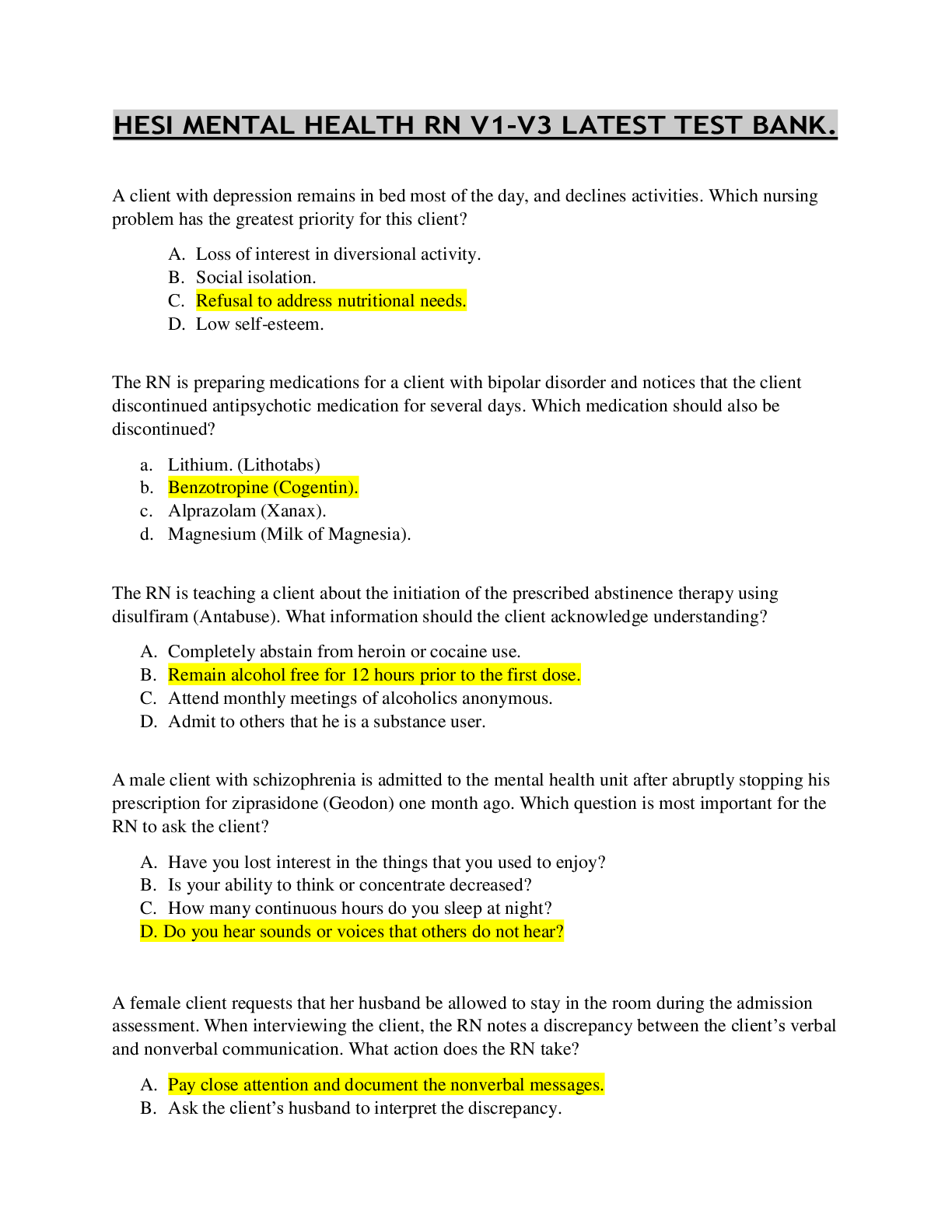
Reviews( 0 )
Document information
Connected school, study & course
About the document
Uploaded On
Oct 09, 2020
Number of pages
46
Written in
Additional information
This document has been written for:
Uploaded
Oct 09, 2020
Downloads
0
Views
118

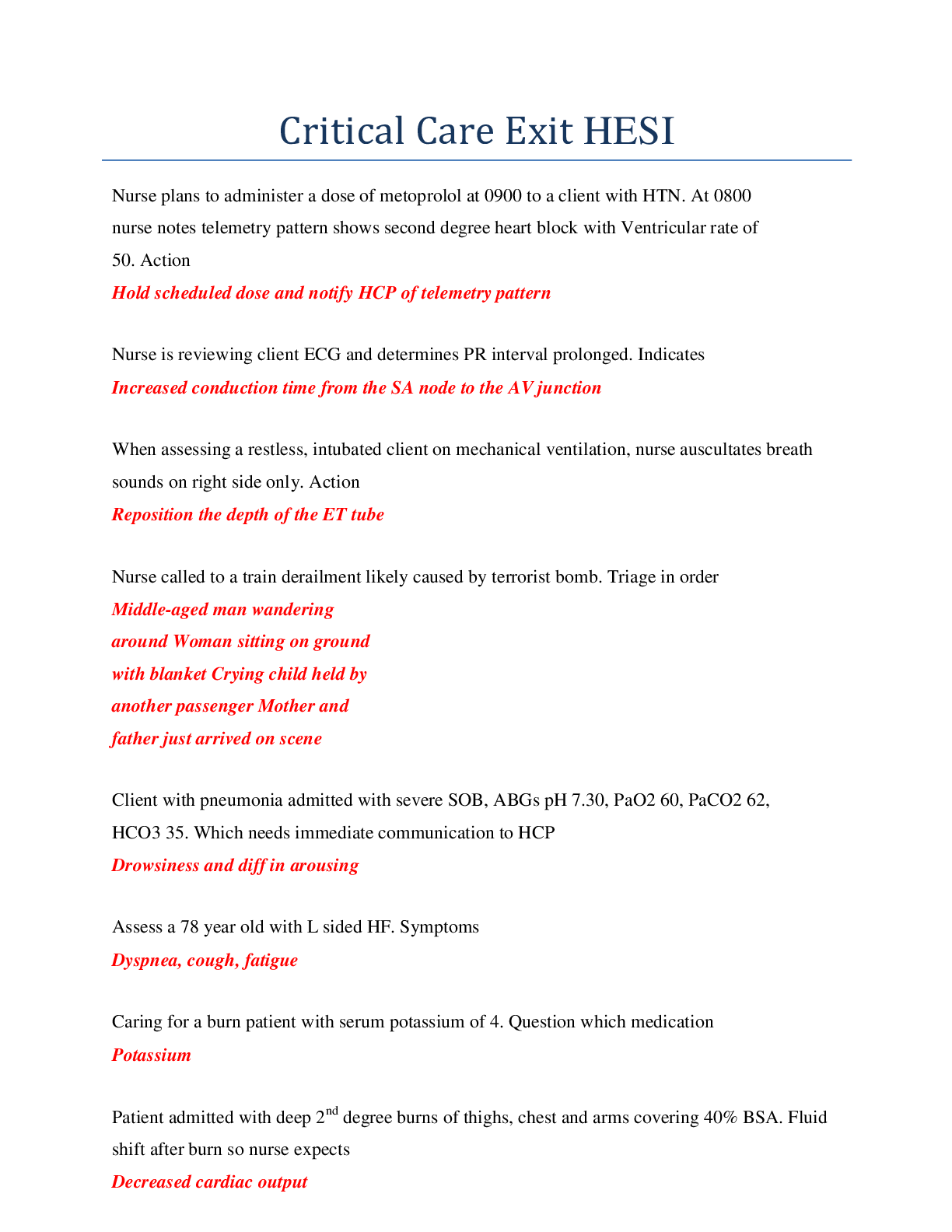
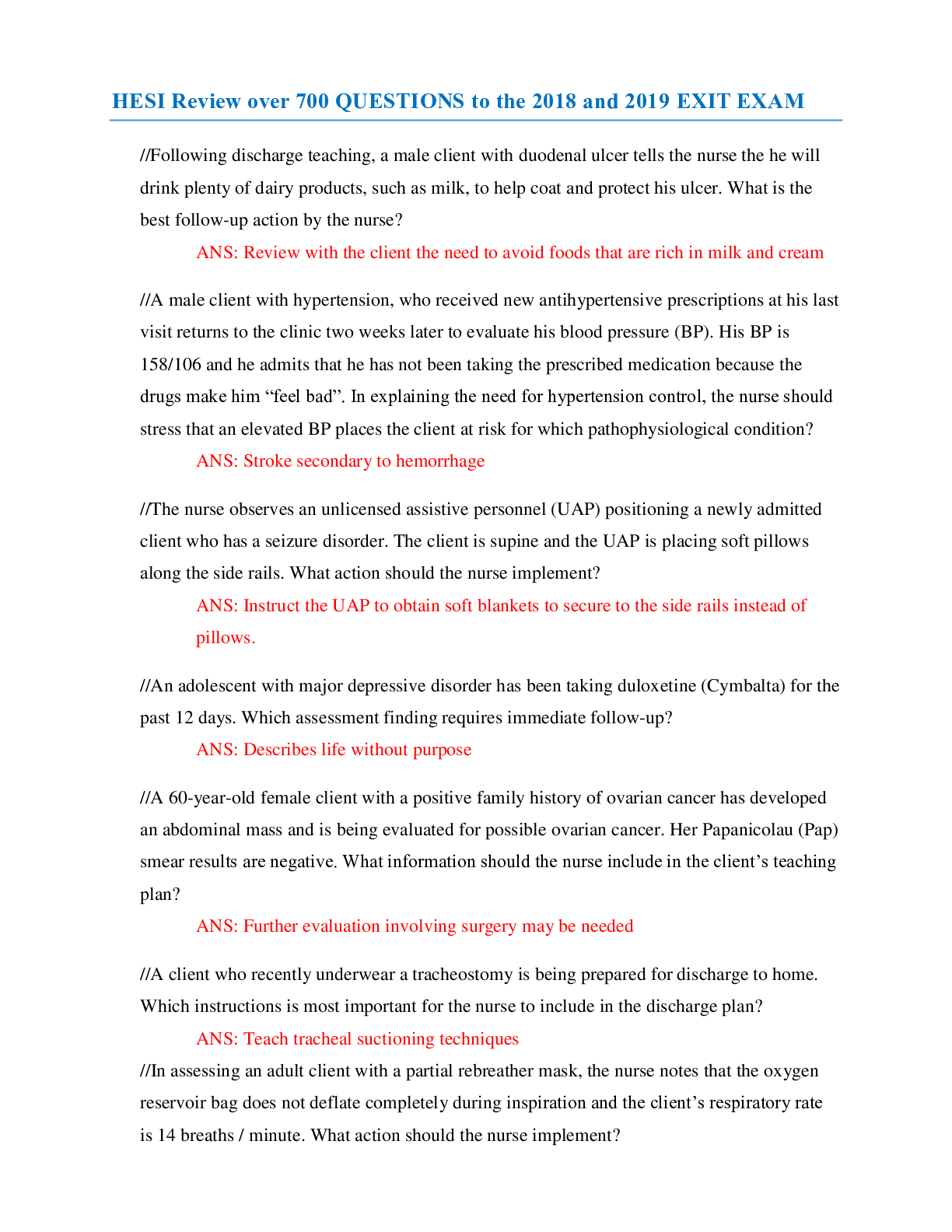
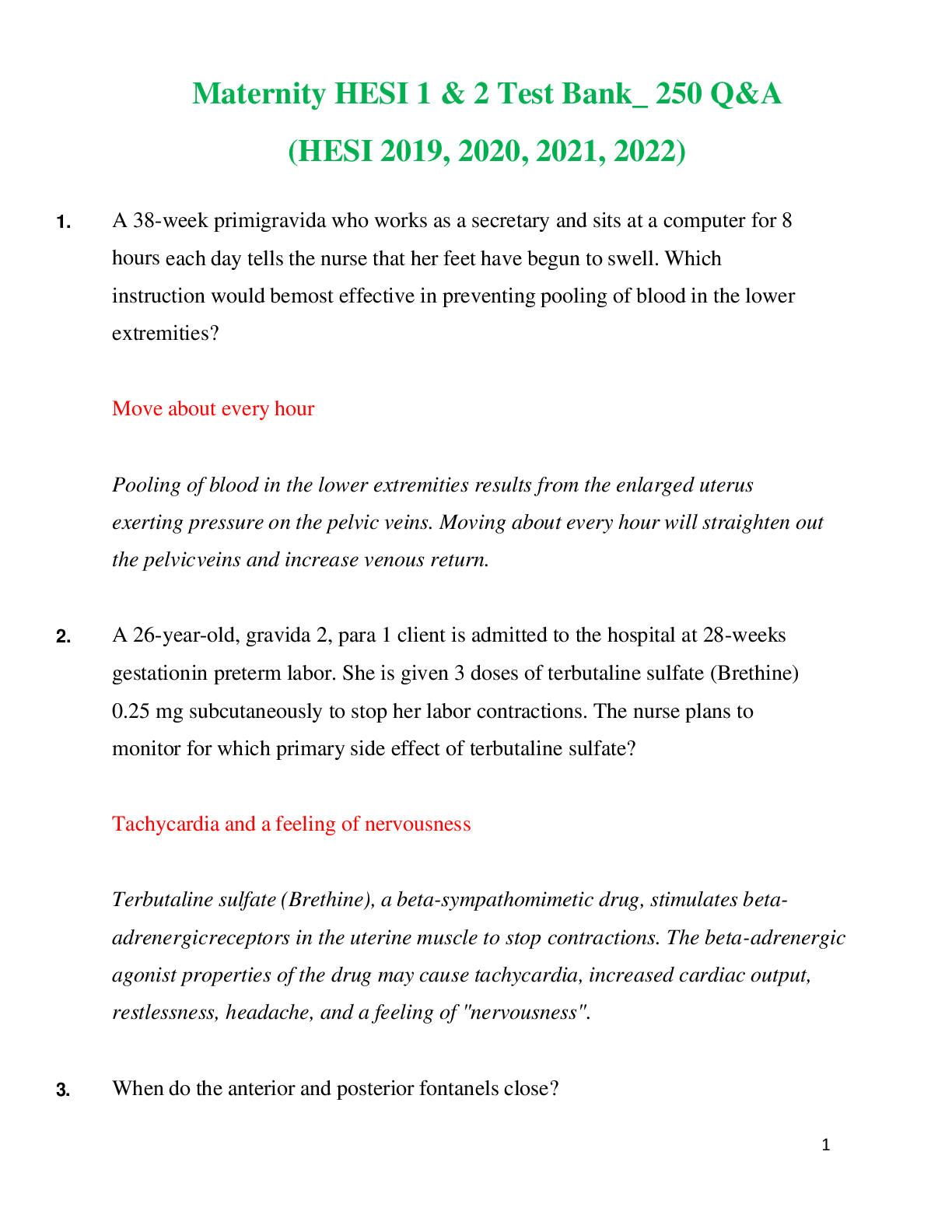
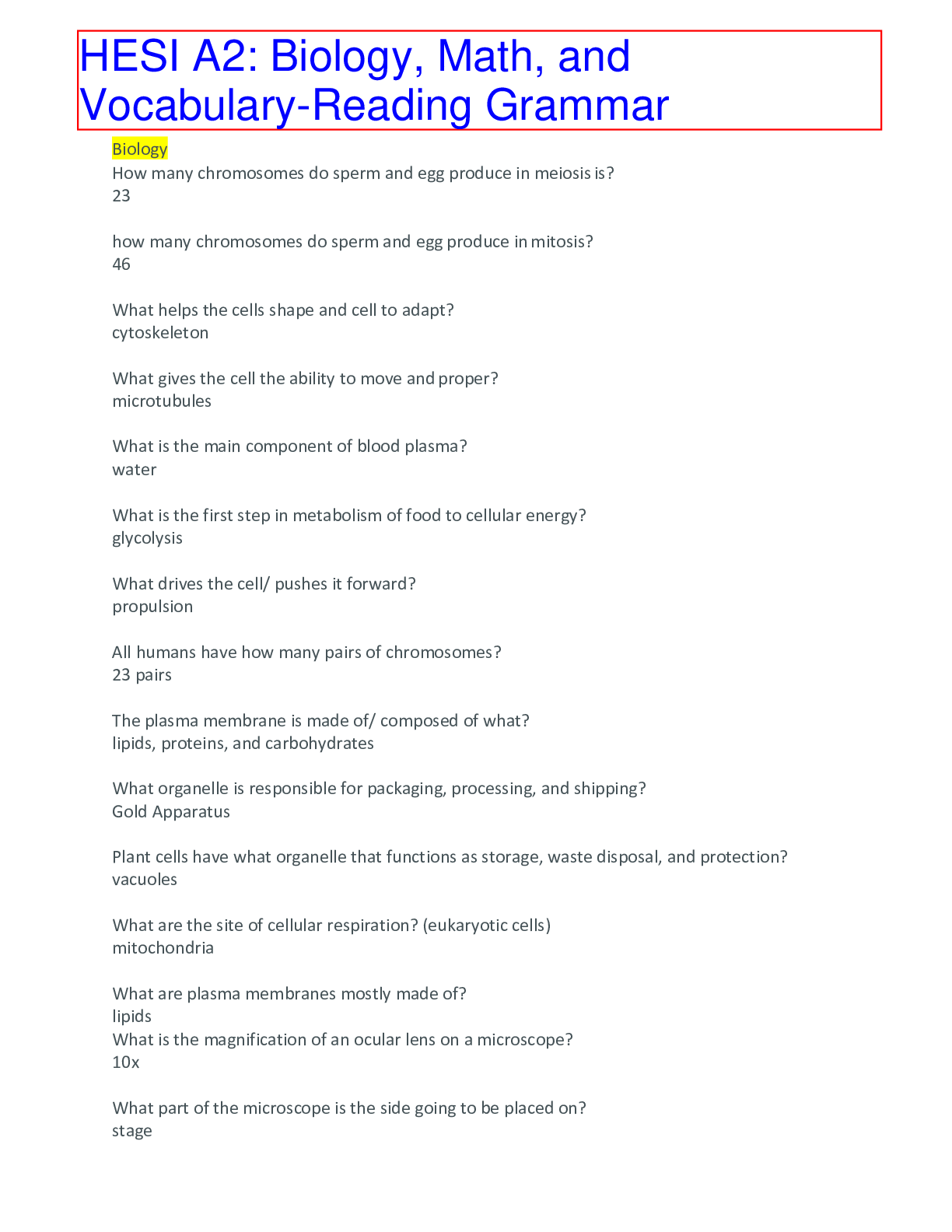
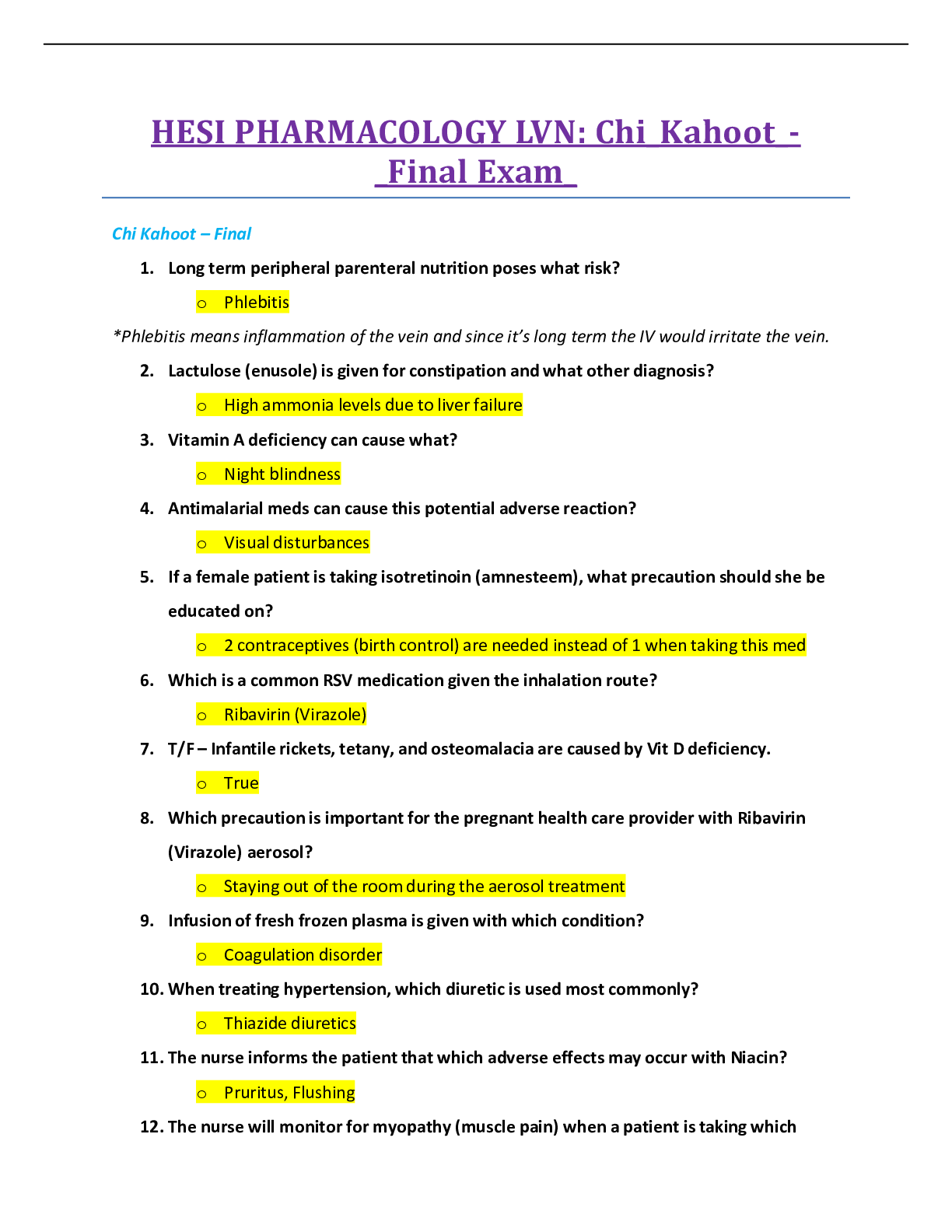
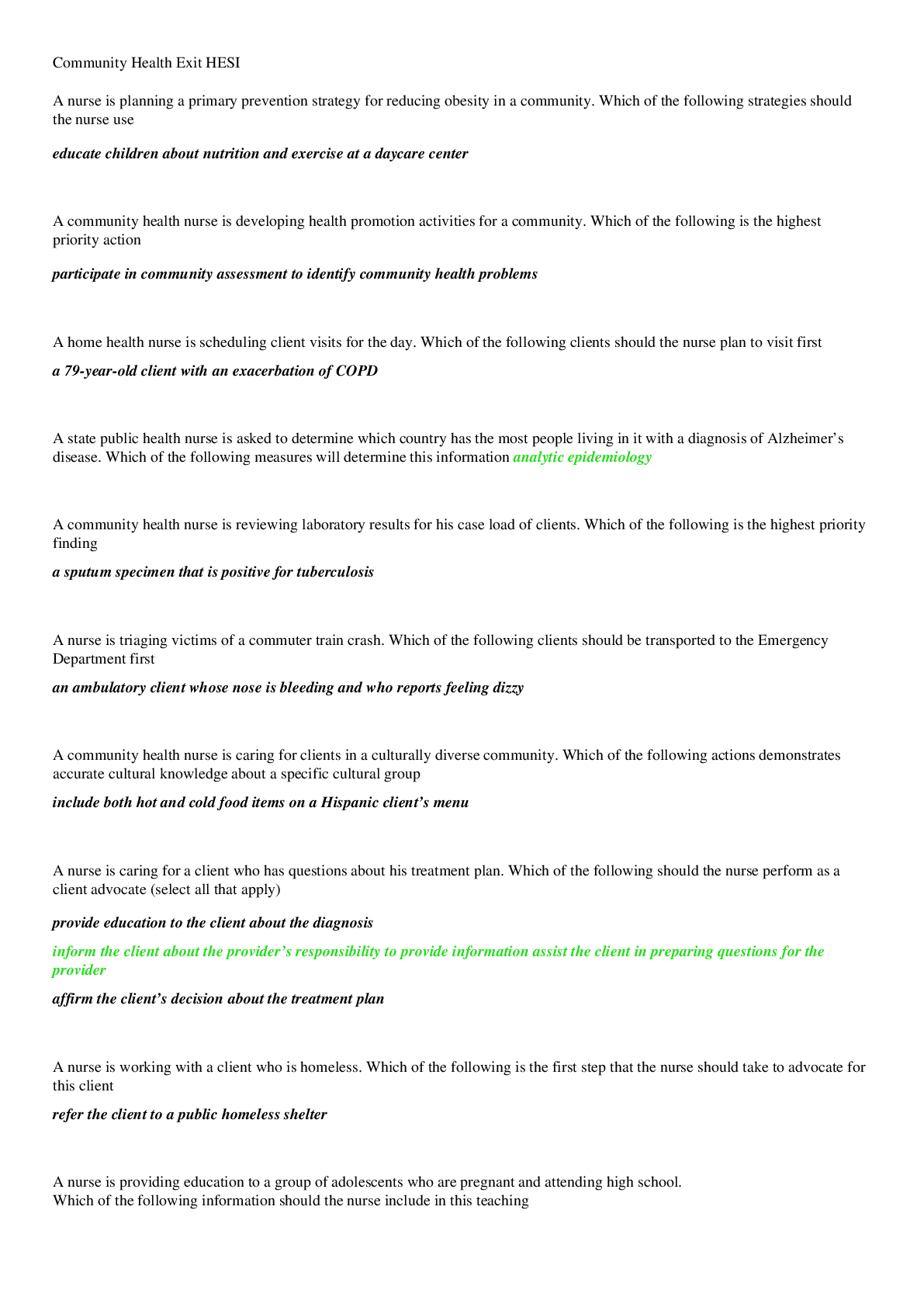
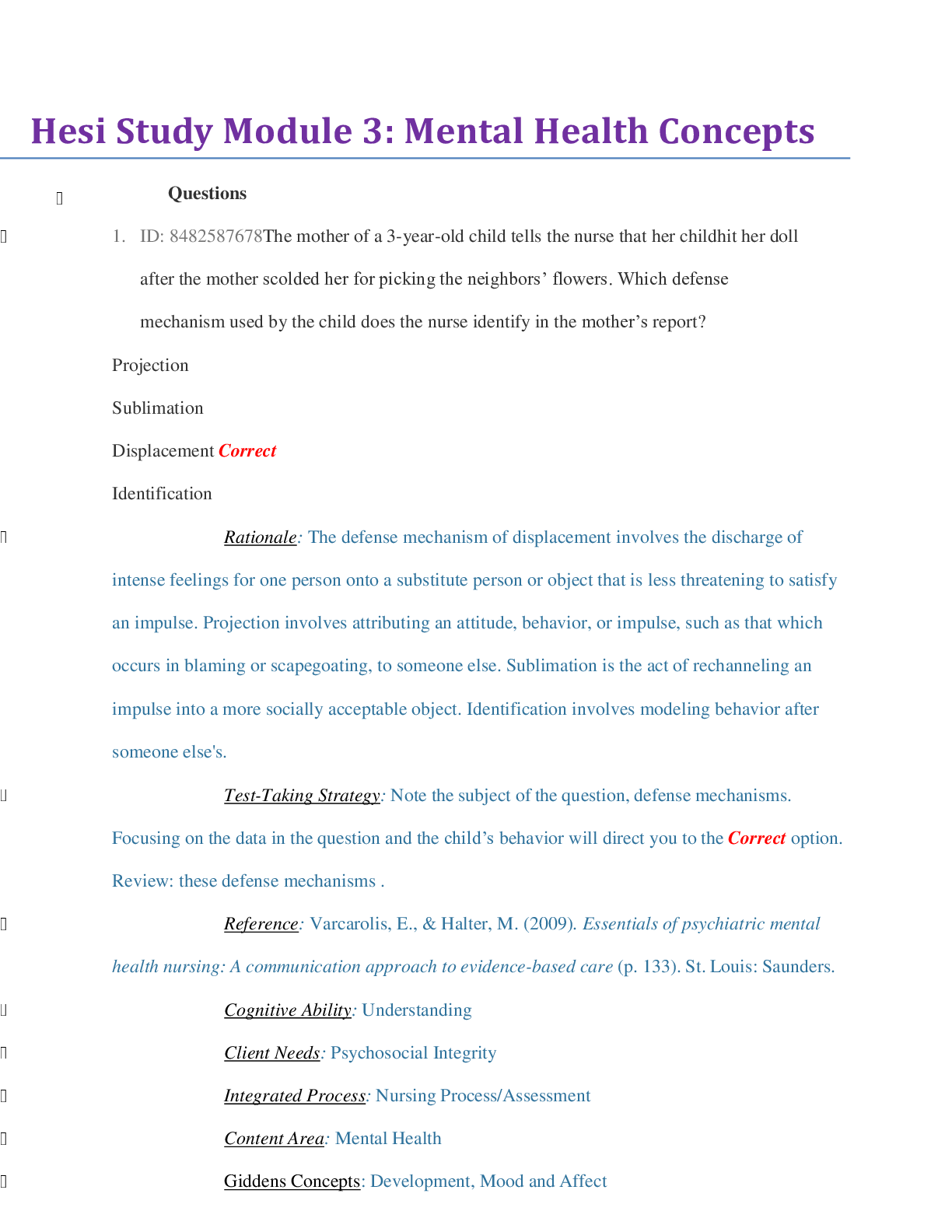
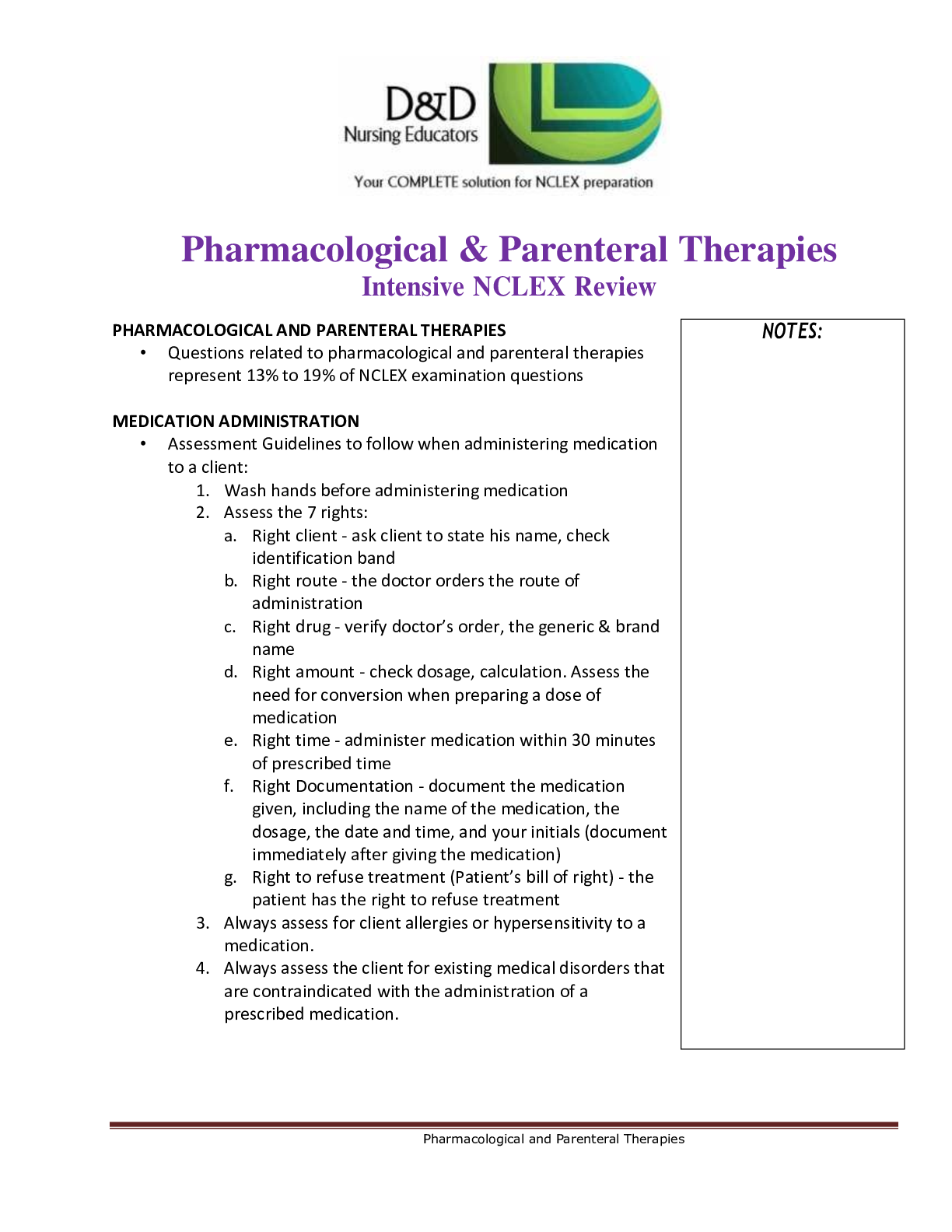
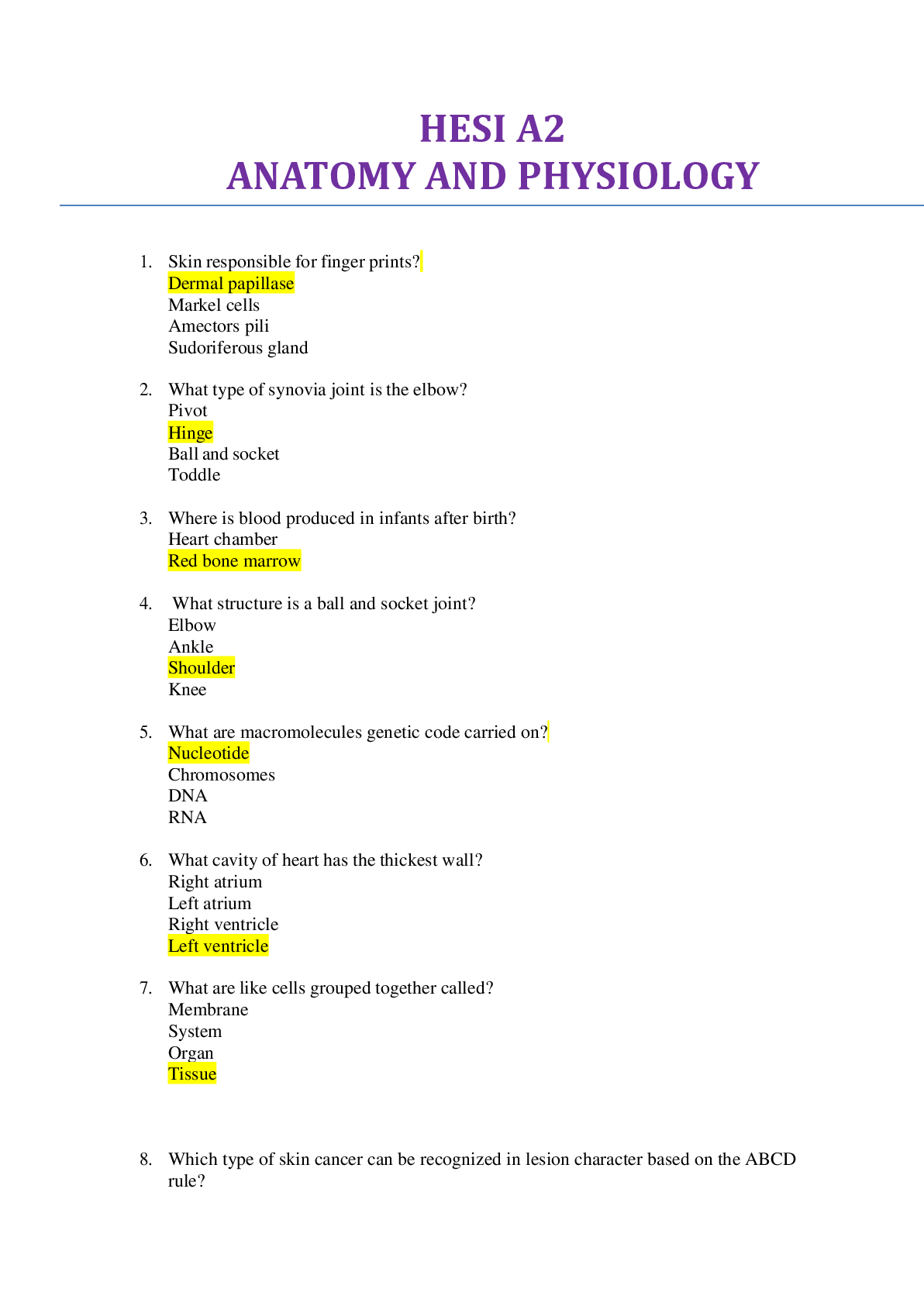
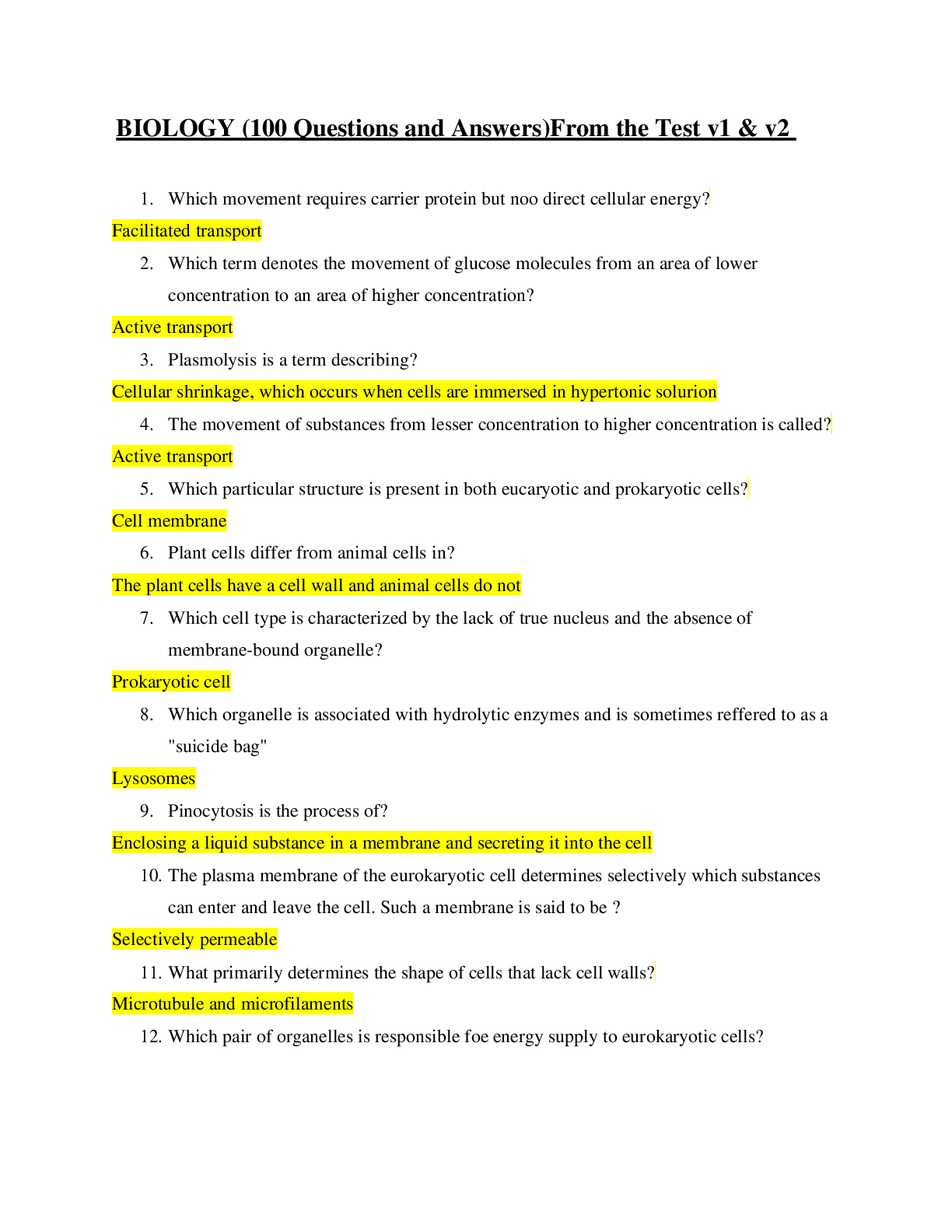
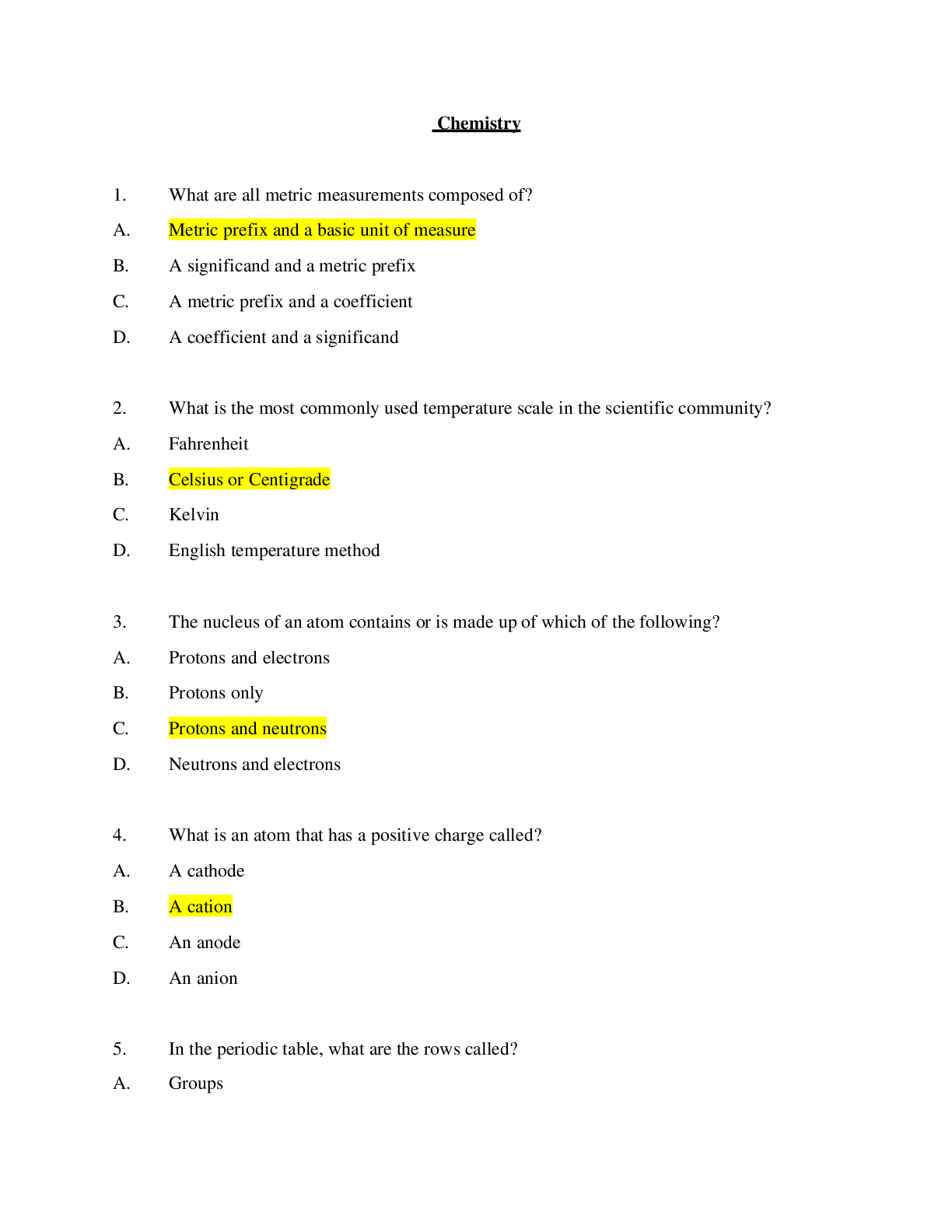
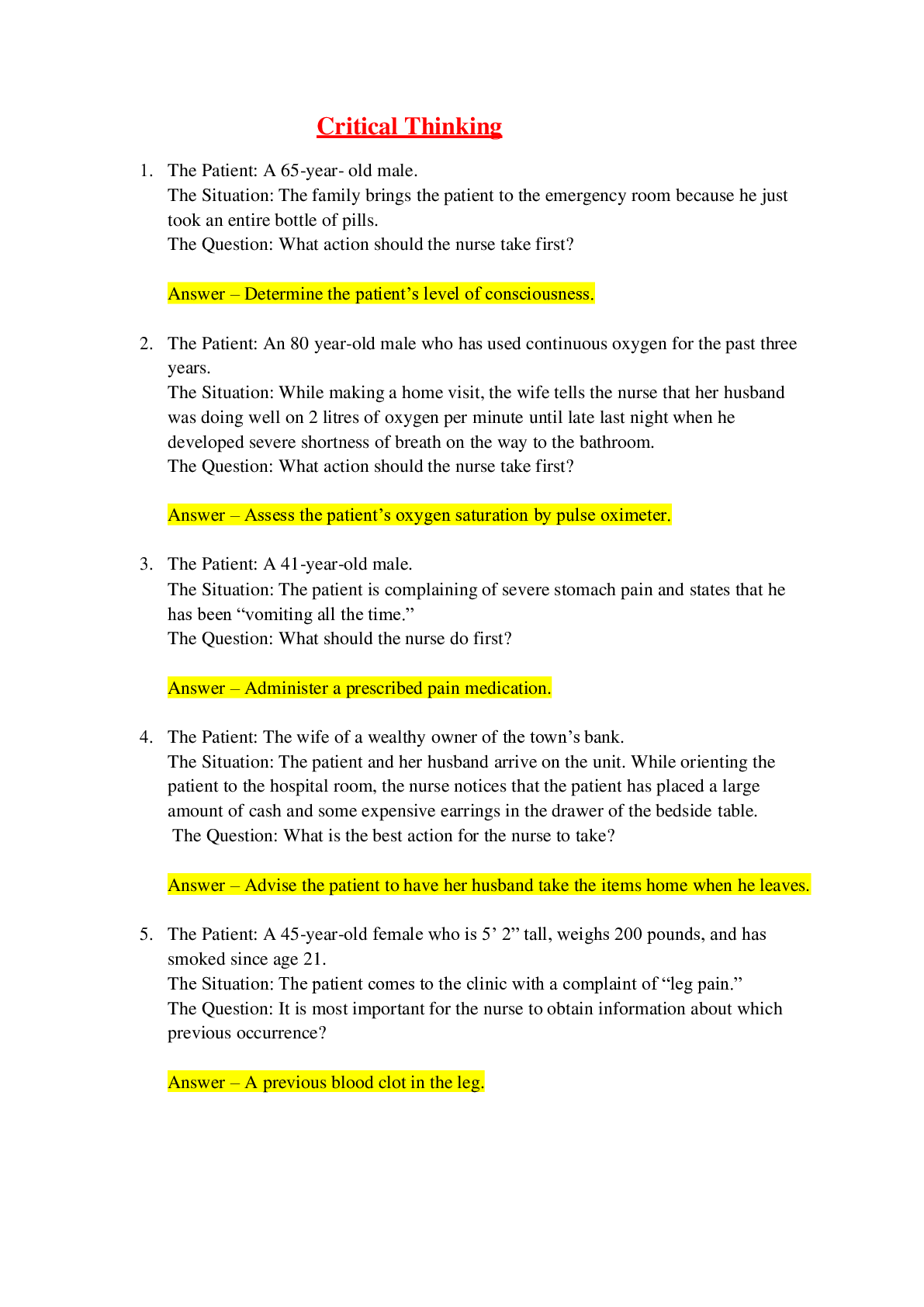
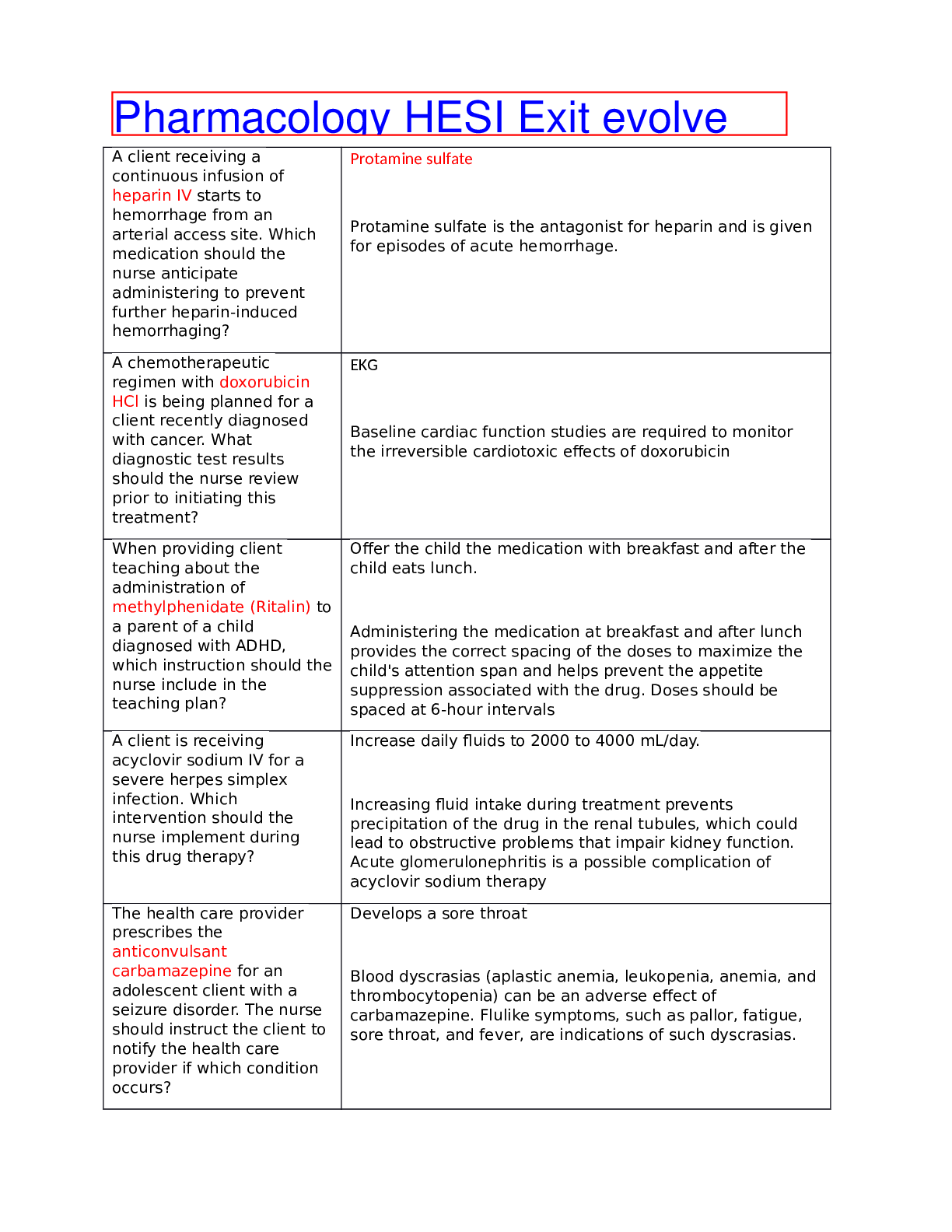
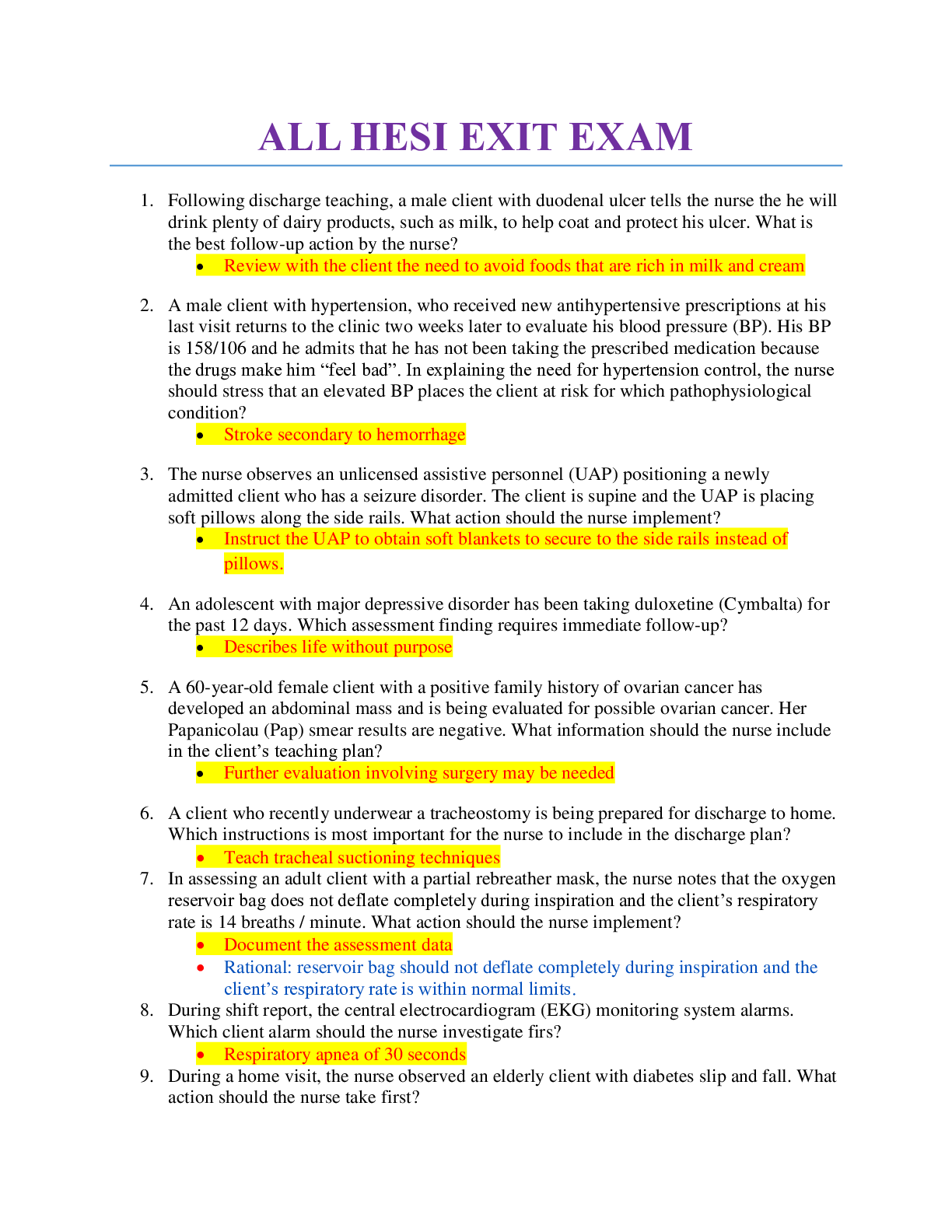

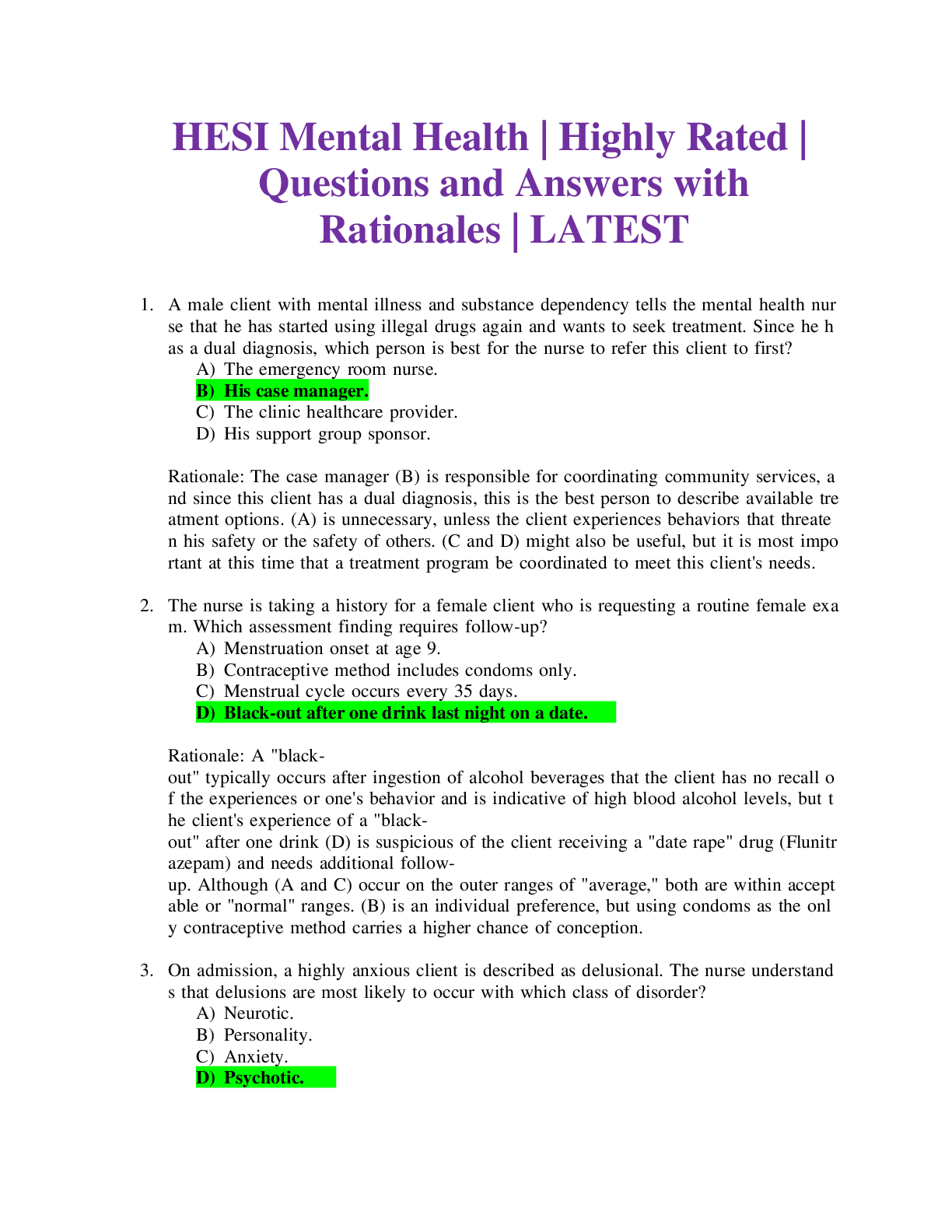
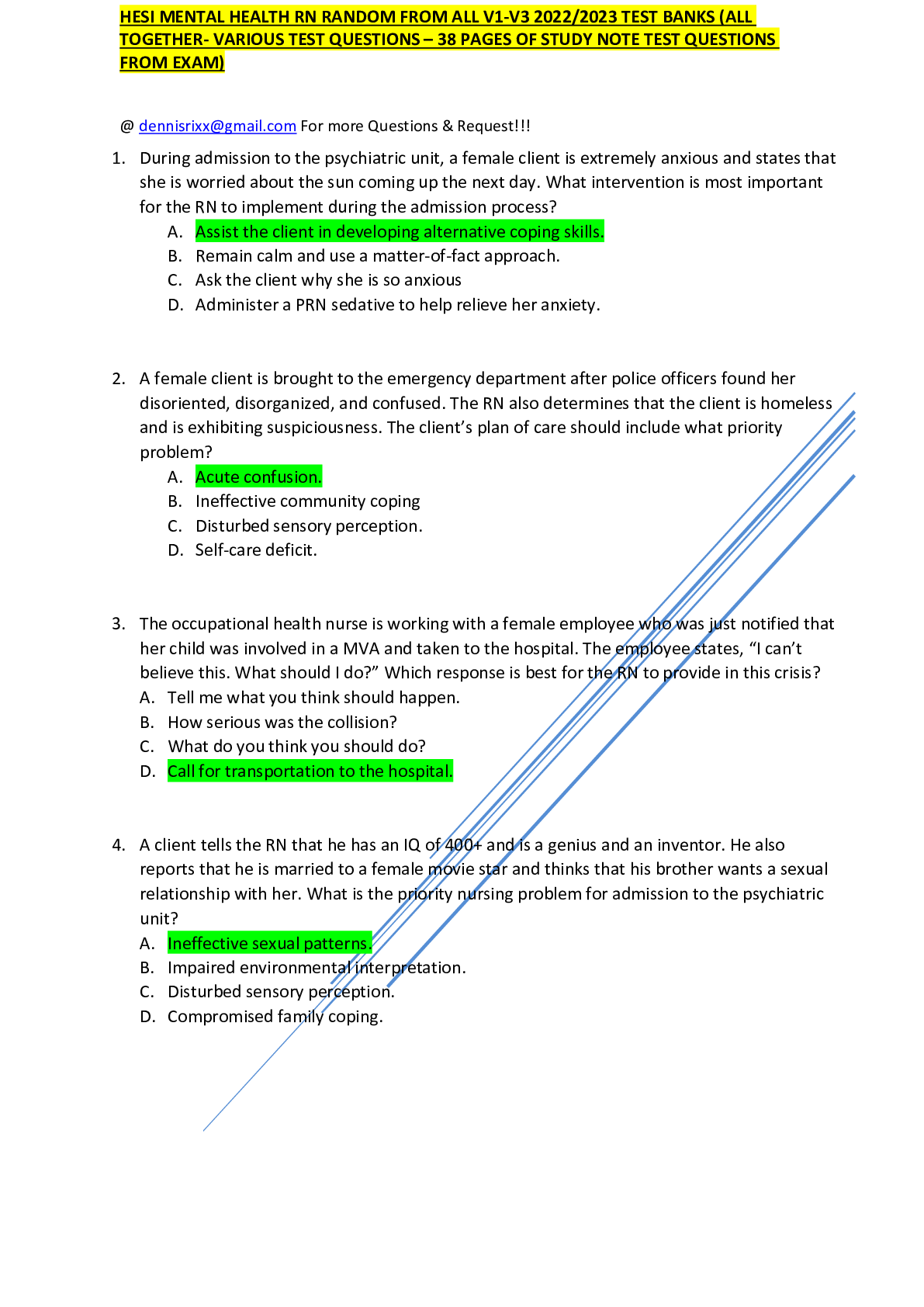
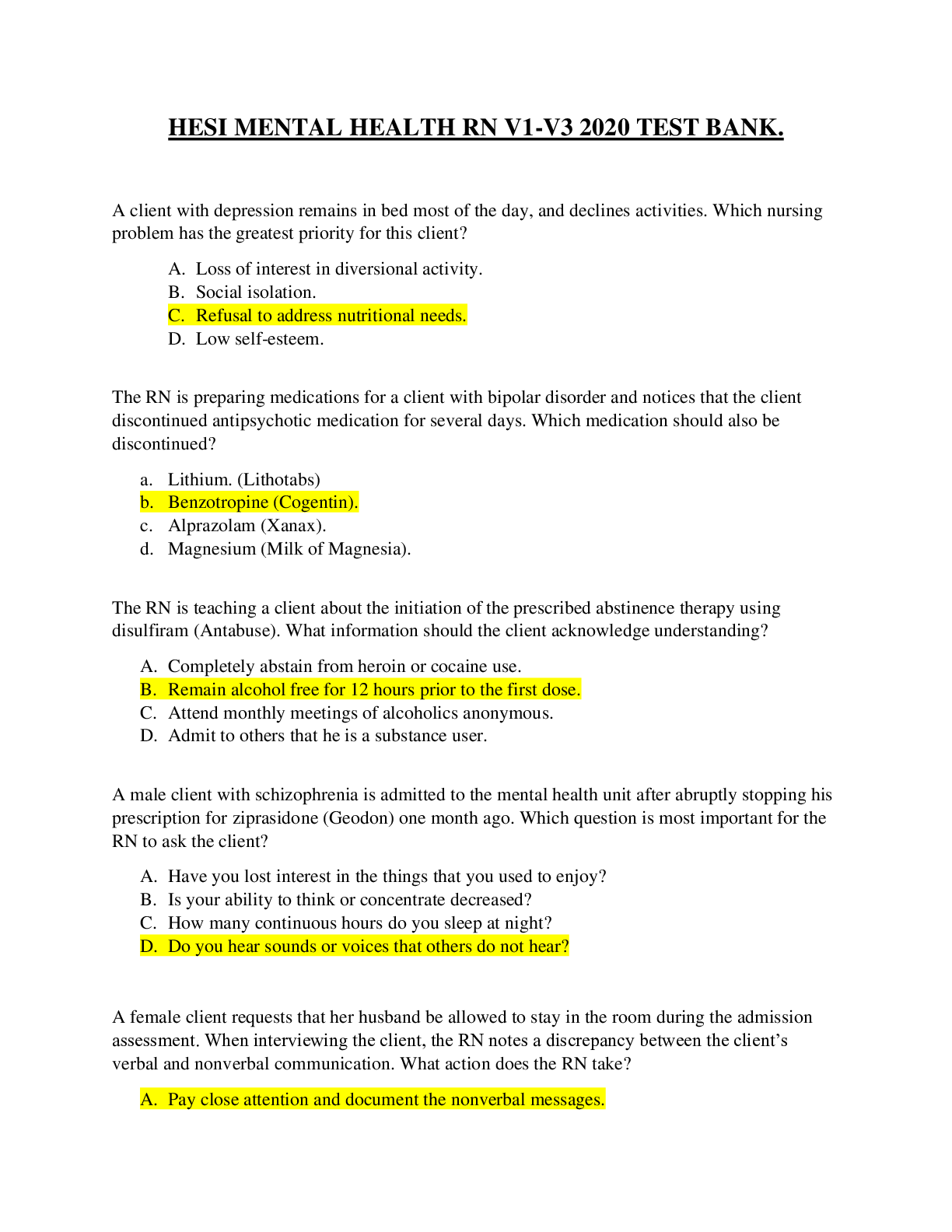
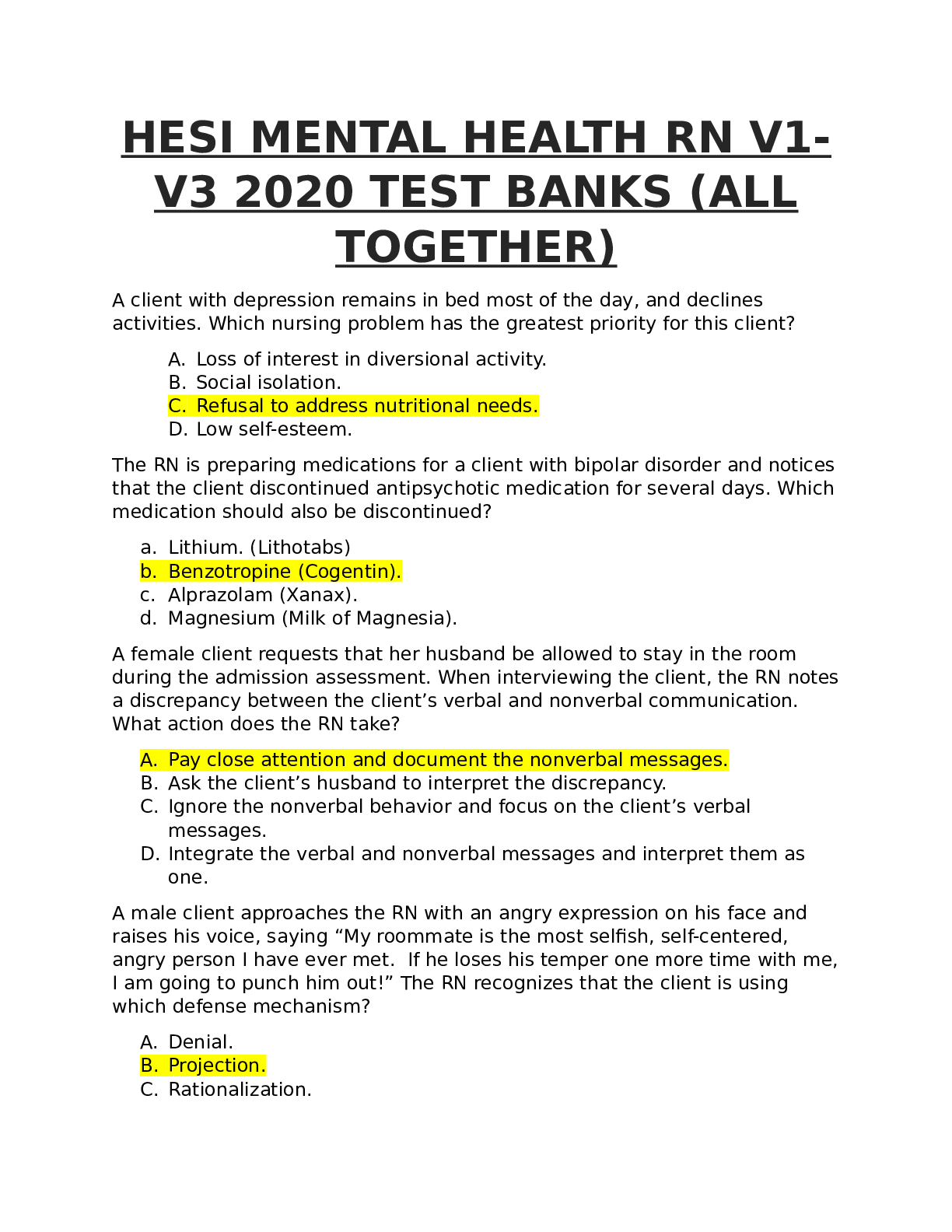

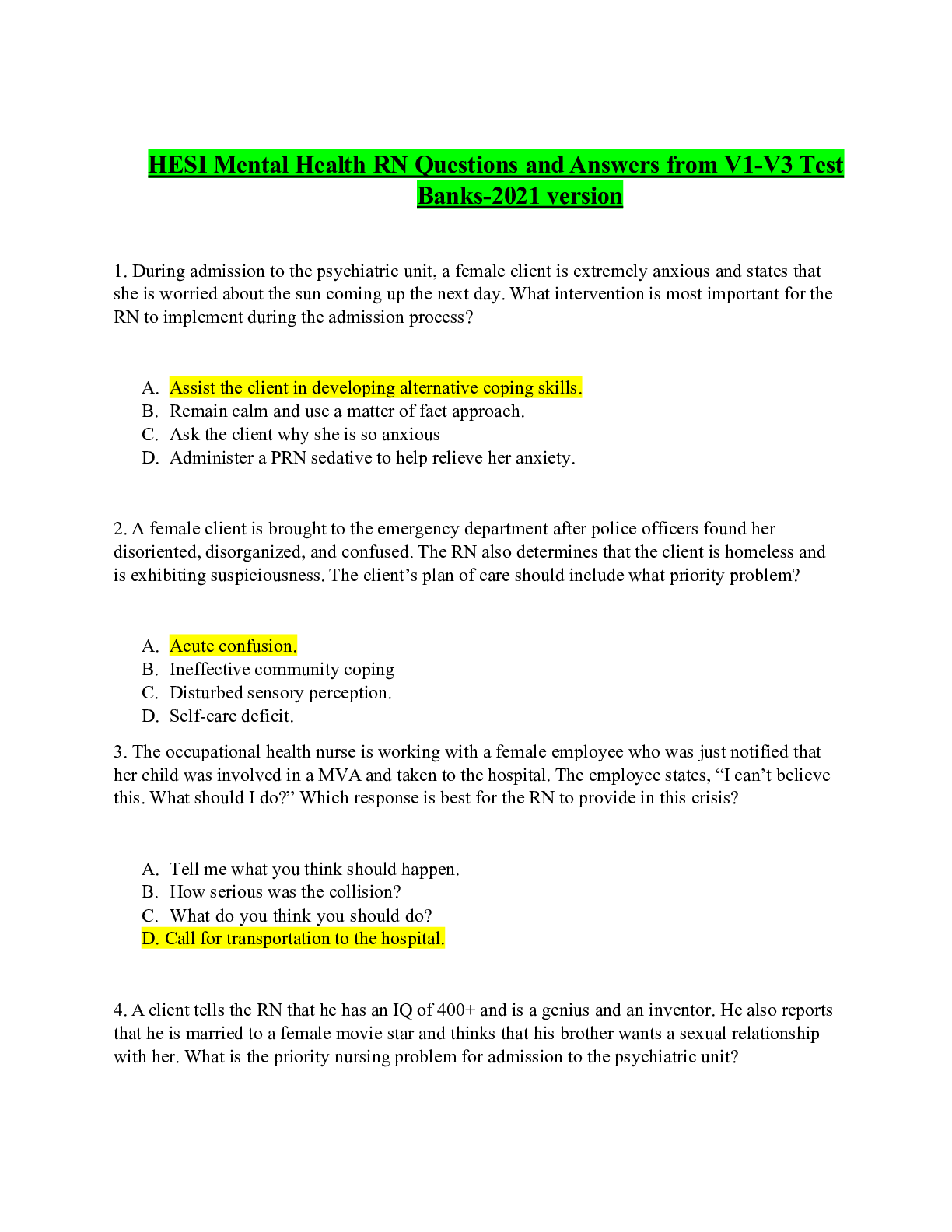
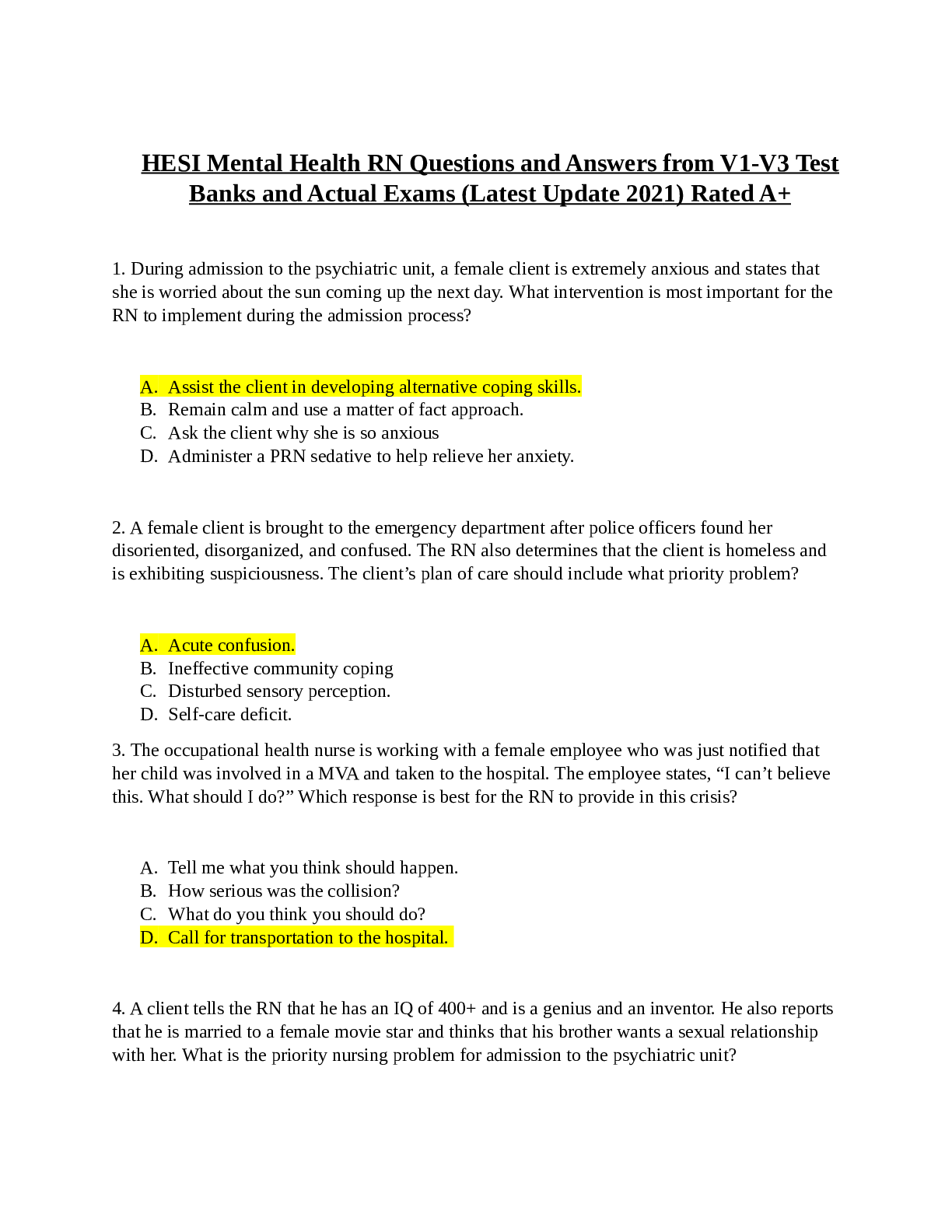
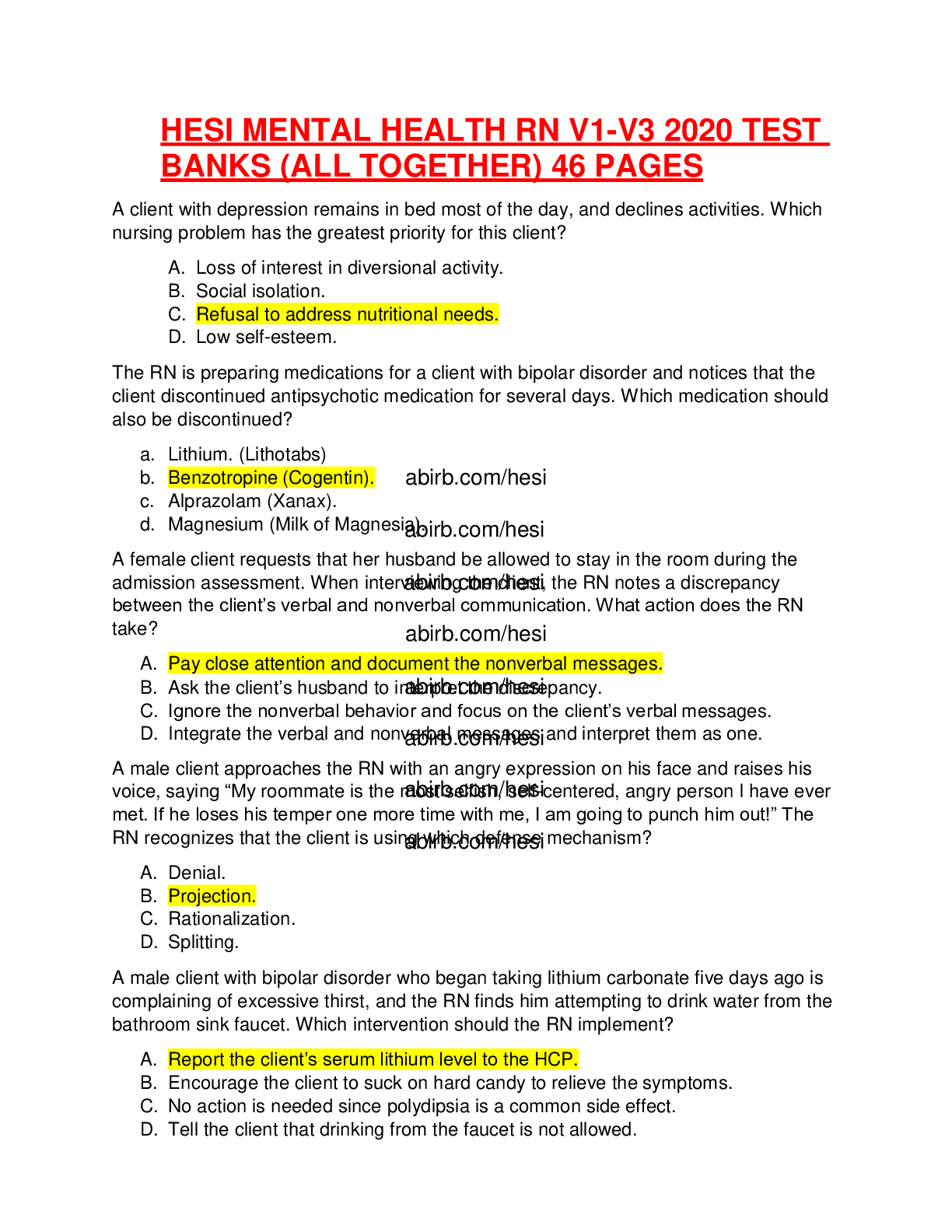
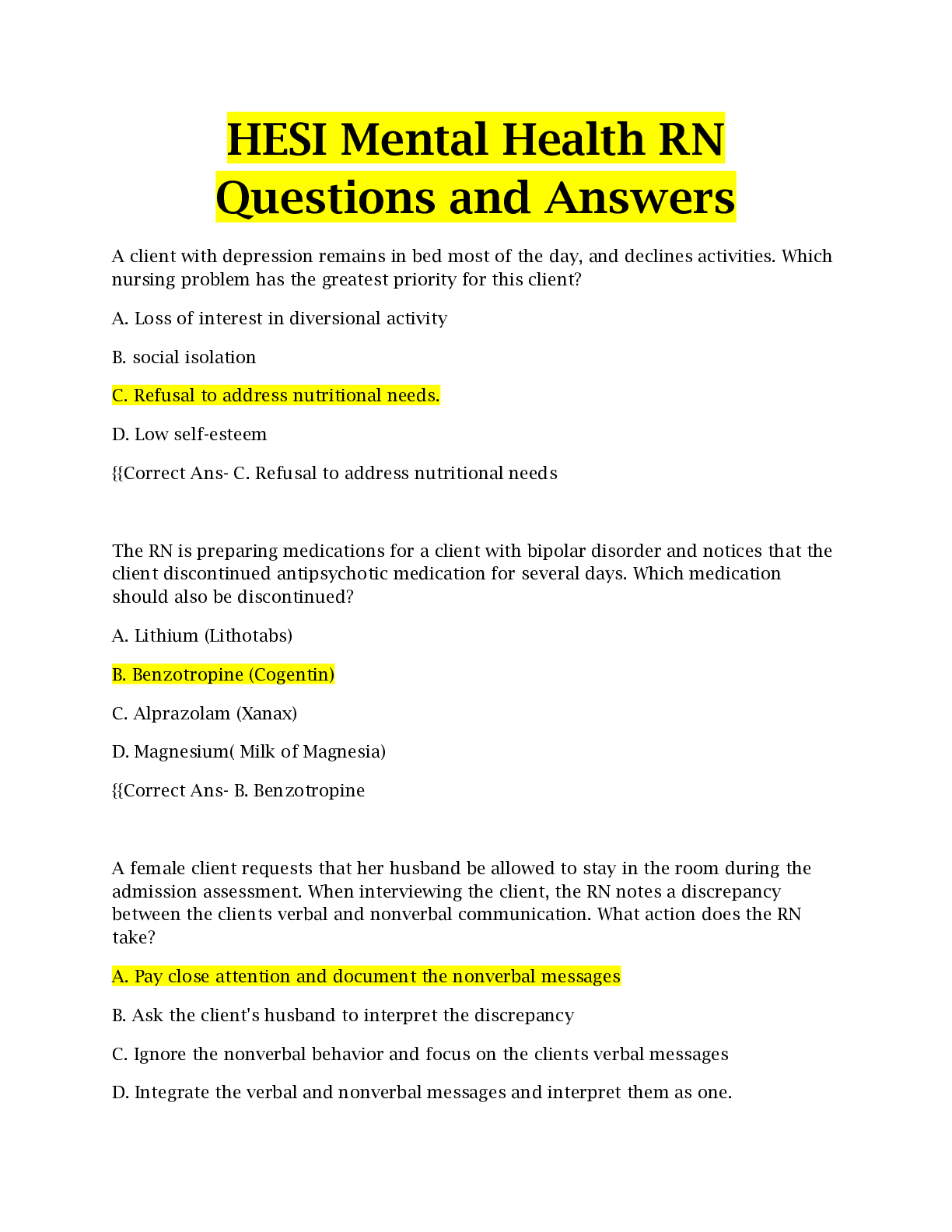
, Latest Questions and Answers with Explanations, All Correct Study Guide, Download to Score A.png)
